Chemistry and Chemists № 1 2024
Journal of Chemists-Enthusiasts
| Content | Chemistry experiments - video | Physics experiments - video | Home Page - Chemistry and Chemists |
|
Chemistry and Chemists № 1 2024 Journal of Chemists-Enthusiasts |
Flowers change colour: effect of alkalis and acids on plant dyes - pt.25, 26, 27 V.M. Viter |
|
Having noticed a mistake in the text, allocate it and press Ctrl-Enter
Red leaf of Quercus rubra (Northern red oak) and ammonia - pt. 25
This tree is similar to Quercus robur (the pedunculate oak), which is common in the forests of Ukraine [1]. Acorns grow on both trees. But there are also differences - the leaves have a completely different shape; the bark and the crown's shape are different. In autumn, the leaves of the pedunculate oak turn yellow, and the leaves of this tree sometimes become yellow but more often turn red. Another difference is that the trunk of older trees of the pedunculate oak is much thicker. A work colleague once said this tree is not an oak but an "oak-like maple." The Internet already existed then, but sites that allowed you to recognize a plant by the photograph did not exist even in the project. There were two ways to identify a plant unknown to you: ask a person who knew or use a large paper handbook with photographs of plants and a description of the criteria to help determine the genus and species. Oh, I almost forgot: in the past, before looking for anything in the handbook, you had first to find (buy, borrow) the handbook itself. Handbooks were often rare and quite expensive. Since I am a chemist and not a biologist, I did not look for a big and heavy paper handbook - I took the man at his word. Many years passed. Recently we were walking in the park with a friend. She is also a chemist. We met the same tree. She claimed that it was an oak tree: - Look: these are acorns! - These are acorns, but the tree is not an oak. I do not remember what it is called. By the way, take a photo of the leaves on your phone and search Google for sites that offer to determine the type of plant by the photo. She did just that. The program identified the tree as Quercus rubra (Latin), Northern red oak (English), Дуб червоний (Ukrainian). This tree is an oak, one of many species of the Oak (Quercus) genus of the Beech (Fagaceae) family. Should I trust people after that? (Sorry for the rhetorical question). __________________________________________________ 1 The Ukrainian name of Quercus robur is "Дуб звичайний", which literally means "Common oak".
What interested me about this plant? The red leaves. As I already wrote, in the autumn, the leaves on this tree often turn red. First of all, it is beautiful. Secondly, red leaves are suitable for our experiments. After the experiment, I found in the literature that the homeland of Northern red oak is... guess what place on the map? You are correct: it is North America, as in the case of the previous plant used for our experiments (Parthenocissus quinquefolia - "wild grape"). Also, both plants have red leaves in the autumn. < irony mode > Can the theory of evolution explain this coincidence? Of course, it cannot. This is irrefutable proof that God created the Universe. < / irony mode > Near the entrance to work, a large tree of Northern red oak grew, but its leaves were not red yet, so I found a small tree of the same species with reddened leaves. I tore off a few leaves for experiments (by the way, the red leaves held on firmly; it took a lot of effort to tear off each leaf). I fixed one red leaf inside a glass jar, added a concentrated ammonia solution and covered the jar with a Petri dish. The colour of the leaf gradually began to change from red to dark green, passing through intermediate colours and shades. I placed the leaf treated with ammonia (dark green) next to an untreated one (red) and recorded a video. When standing in the air, the dark green leaf of Northern red oak (treated with ammonia) acquired a brown tint, and over time it became brown. |
|
Красный лист Quercus Rubra (Дуб красный) и аммиак - ч.25
Это дерево похоже на Дуб обыкновенный (латин. Quercus robur, укр. - Дуб звичайний), такой привычный для лесов Украины. На обоих деревьях растут желуди. Но есть и отличия - листья совсем другой формы, отличается кора и форма кроны. Осенью листья Дуба обыкновенного становятся желтыми, а на этом дереве - иногда желтыми, но чаще - красными. Еще одно отличие: ствол у старых экземпляров Дуба обыкновенного гораздо толще. Коллега по работе как-то сказал, что данное дерево - не дуб, а "дубовидный клен". Интернет тогда уже был, но сайтов, которые позволяют распознать растение по фотографии - не существовало даже в проекте. Было два способа идентифицировать неизвестное тебе растение: спросить у человека, который знает, или воспользоваться большим бумажным справочником с фотографиями растений и описанием критериев, которые помогают определить родовую и видовую принадлежность. Ах да... В прошлом перед тем, как что-либо искать в справочнике, для начала нужно было найти (купить, одолжить) сам справочник. Справочники часто были редкими и довольно дорогими. Поскольку я химик, а не биолог, разумеется, искать "толстый бумажный справочник" не стал - поверил человеку на слово. Прошло много лет. Недавно мы гуляли в парке со знакомой. Она - тоже химик. Встретили это же дерево. Она утверждала, что это - дуб: - Посмотри: это - желуди! - Да, это желуди, но дерево - не дуб. Не помню, как оно называется. Кстати, сфотографируй листья на телефон и задай в Google поиск сайтов, которые определяют вид растения по фотографии. Она так и сделала. Программа идентифицировала дерево как Quercus rubra (лат.), Northern red oak (англ.), Дуб червоний (укр.), Дуб красный (рус.). Данное дерево - таки дуб, представитель одного из многих видов рода Дуб (Quercus) семейства Буковые (Fagaceae). Вот и верь после этого людям! Что меня заинтересовало в этом растении - красные листья. Как я уже писал, осенью листья на Дубе красном часто краснеют (и кто бы мог подумать...). Во-первых, это красиво. Во-вторых, красные листья как раз подойдут для наших экспериментов. Уже после эксперимента посмотрел, что родиной Дуба красного является..., угадайте, какое место на карте? Правильно: Северная Америка, как и в случае с предыдущим растением, использованном для наших экспериментов (Parthenocissus quinquefolia - "дикий виноград"). И оба растения осенью - с красными листьями. < irony mode > Может теория эволюции объяснить такое совпадение? Разумеется - нет, это является неопровержимым доказательством того, что Вселенную создал Бог. < / irony mode > Возле входа на работу растет большое дерево данного вида - Дуб красный, но листья на нем пока что не были красными, поэтому я нашел маленькое деревце этого же вида с покрасневшими листьями. Сорвал несколько листьев для экспериментов (кстати, красные листья держались прочно: чтобы сорвать каждый лист приходилось прилагать большие усилия). Один красный лист подвесил внутри стеклянной банки. Добавил концентрированный раствор аммиака, накрыл банку чашкой Петри. Цвет листа постепенно стал меняться с красного на темно-зеленый, проходя промежуточные цвета и оттенки. Поместил обработанный аммиаком лист (темно-зеленый) рядом с необработанным (красный) - снял на видео. При стоянии на воздухе обработанный аммиаком лист Дуба красного (темно-зеленый) приобрел коричневый оттенок, а со временем стал коричневым. |

Quercus rubra (Northern red oak) |
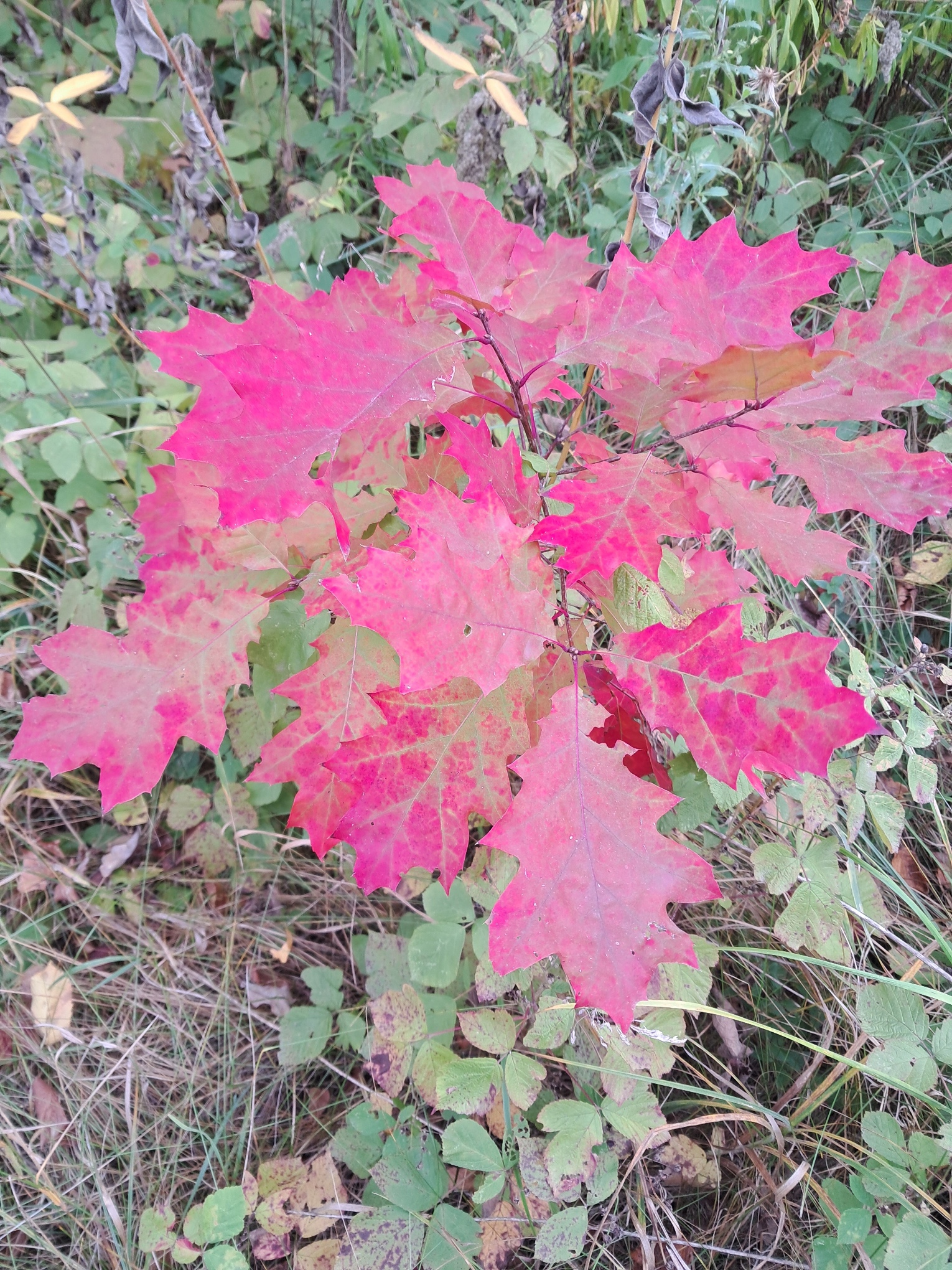
|

Red leaf of Quercus rubra (Northern red oak) and ammonia |
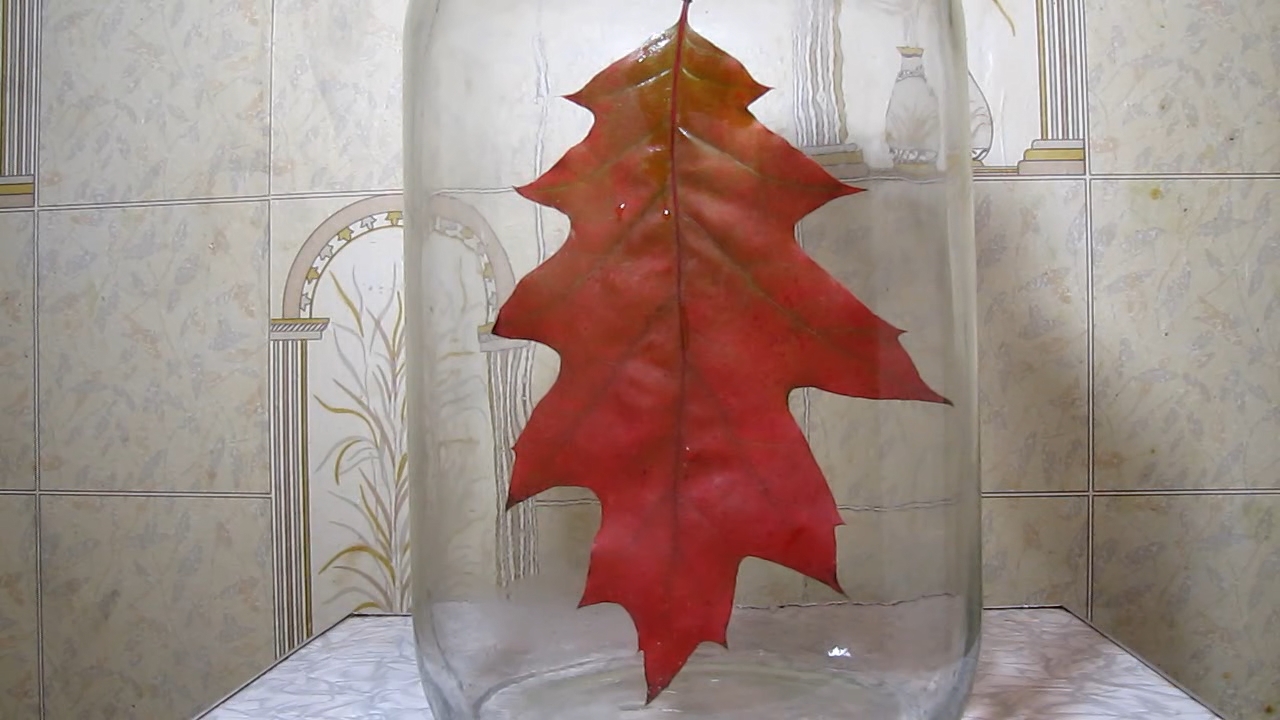
|
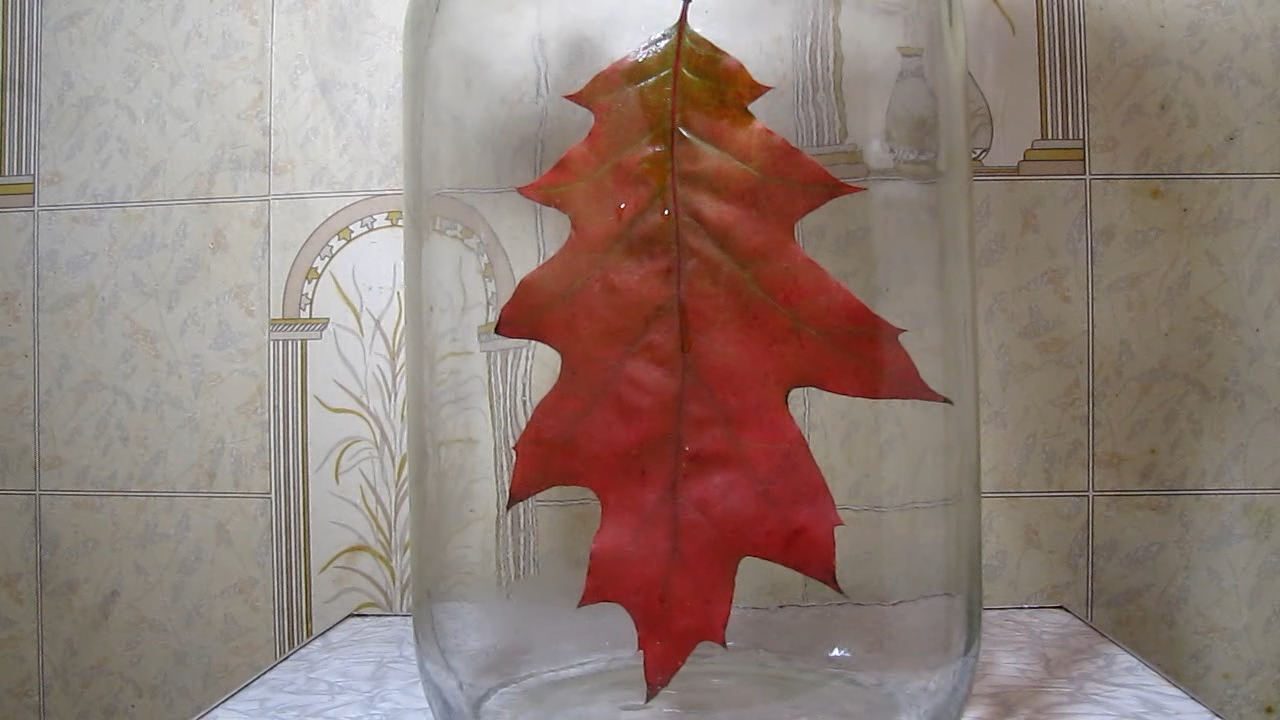
|

|
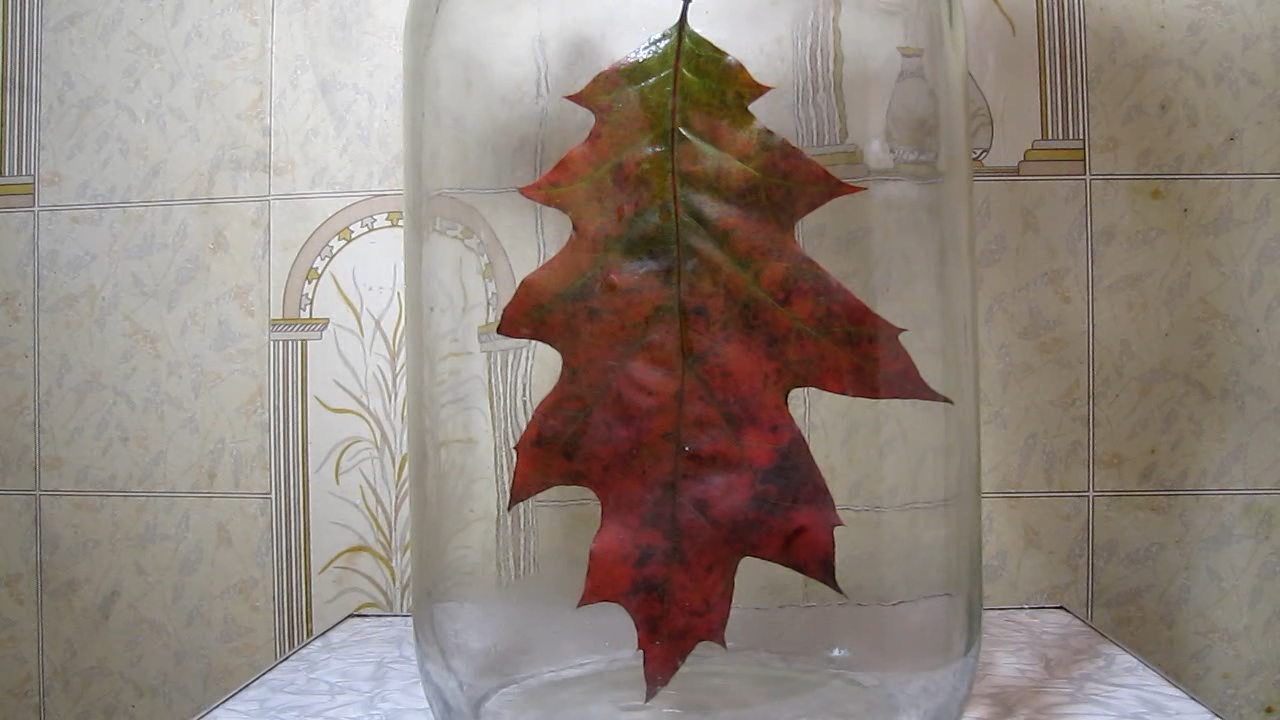
|
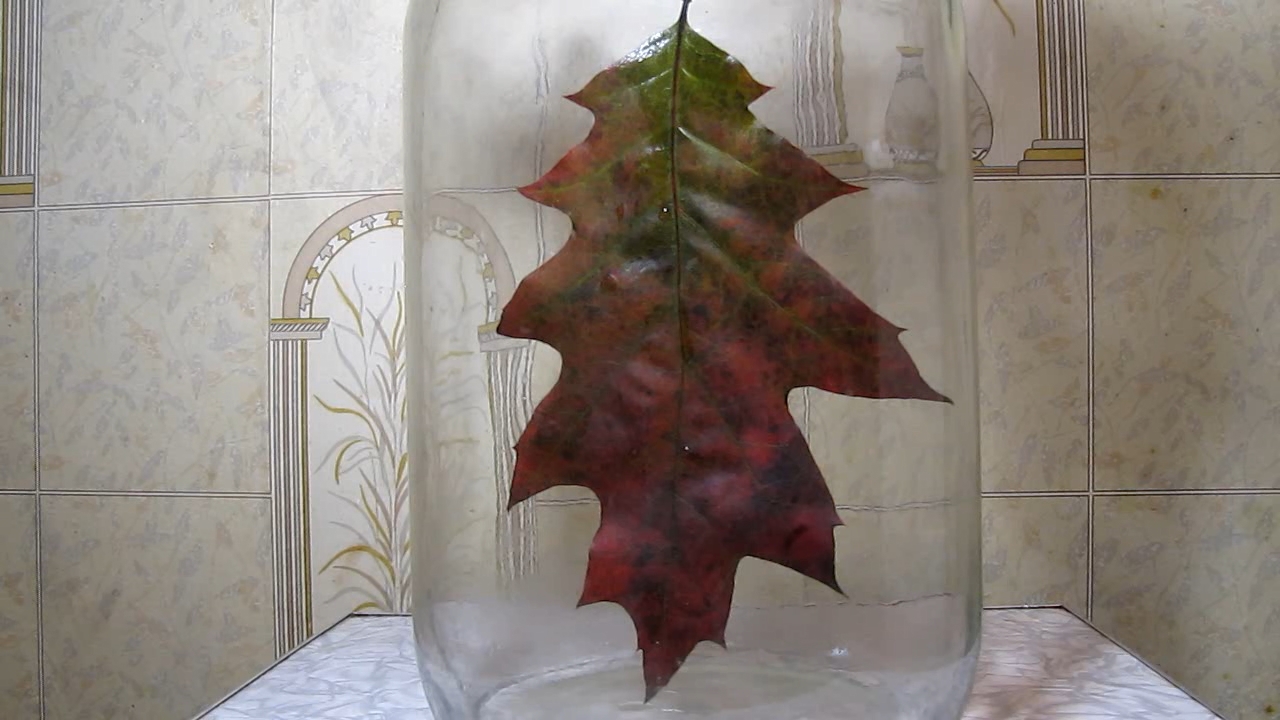
|
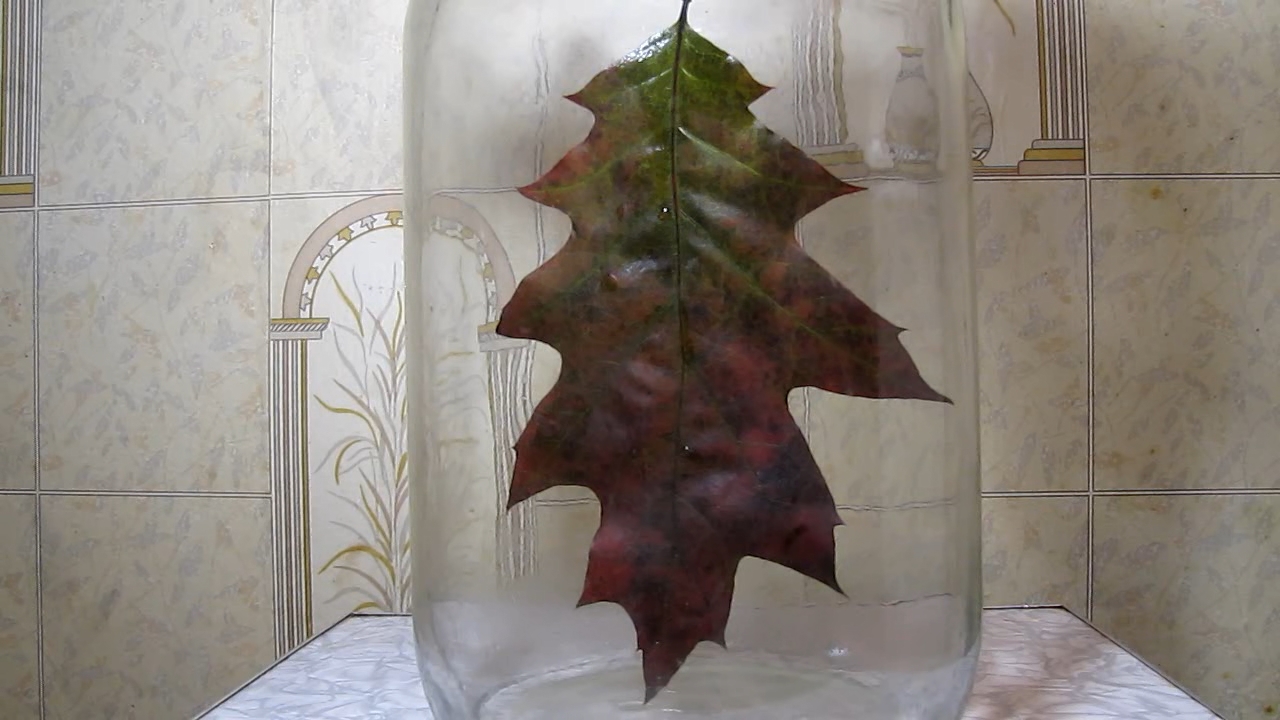
|
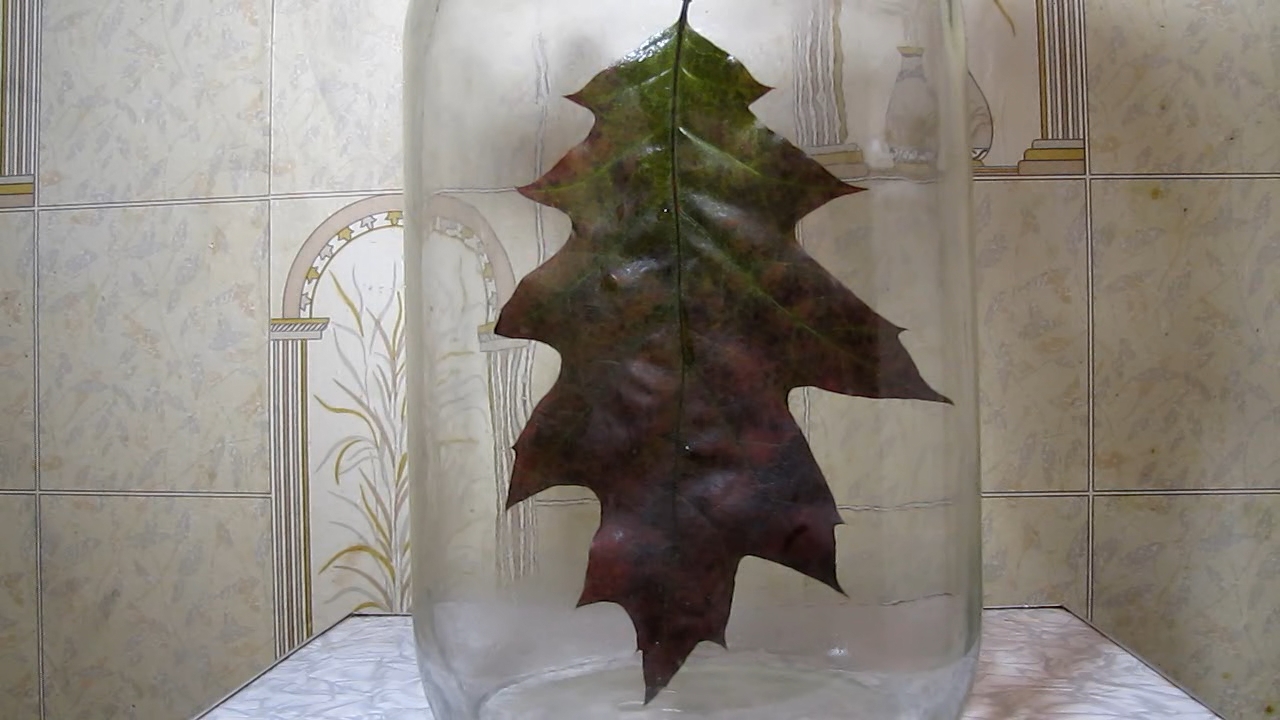
|
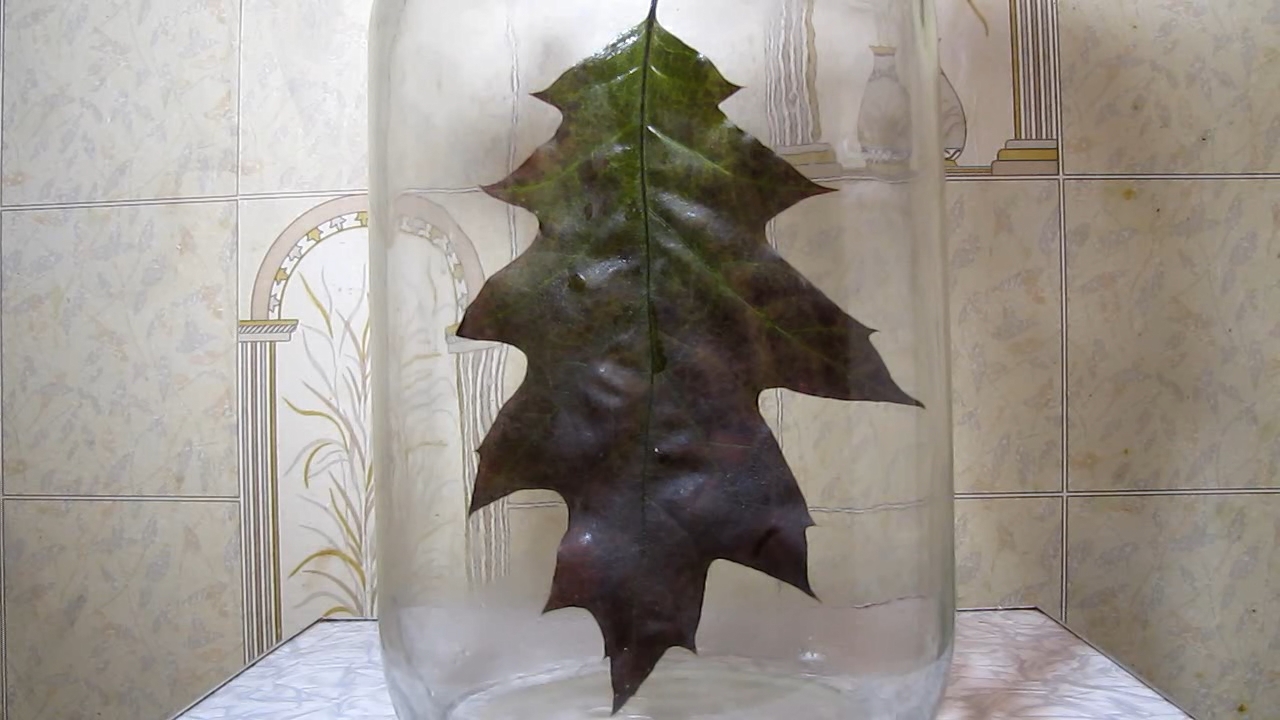
|
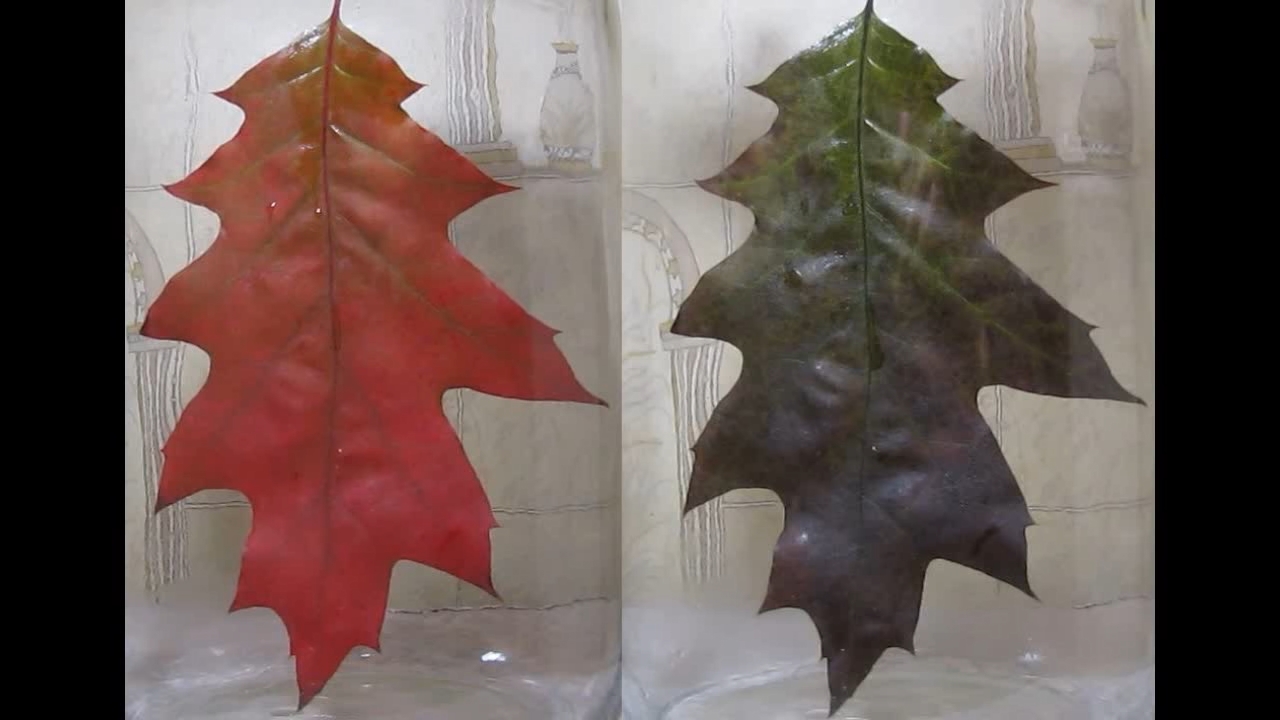
|
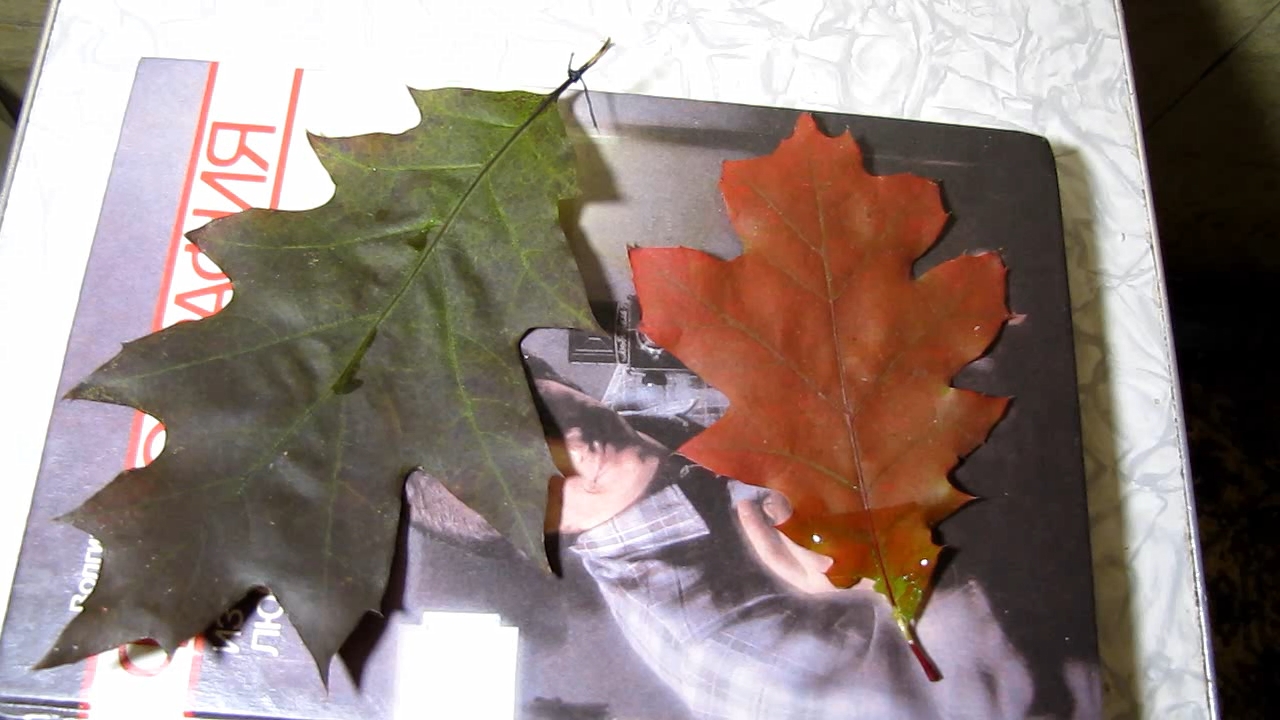
|

|
|
Burgundy autumn leaves become green (treatment of leaves of Ulmus laevis with ammonia) - pt. 26
We have more or less figured out the behaviour of the red autumn leaves. What about burgundy ones? I assumed that the colour change of burgundy leaf dye in an alkaline medium would be similar to that of red leaves. What will happen in an acidic medium? After the failure with red leaves and glacial acetic acid, I was reluctant to try such an experiment. Why should I do the experiment that is likely to fail when I can do many other experiments which are likely to be successful (perhaps even with a beautiful colour transition)?In the summer, I had noticed a tree with leaves which turned burgundy in the autumn. Such trees grow everywhere in our country: in forests and parks. For most of my life, I thought it was a species of the Alders genus. Later, friends said that this was NOT Alders. I found the correct name of the tree only after the experiments. It turns out that this biological species belongs to another genus and family and is called Ulmus laevis (Latin), European white elm, fluttering elm, spreading elm, stately elm (English), В'яз гладкий (Ukrainian), further in the text "elm". Elm is native to Europe. The trees reach a height of up to 40 m and often grow in mixed forests. The leaves are oval or ovate (that is why I confused it with Alders). In summer, the leaves are green; in autumn, they turn yellow or burgundy. Not far from my work, two elms grew nearby; the leaves turned yellow on one tree and became burgundy on the other. There, I took several burgundy leaves for experiments.
I hung a large burgundy leaf of the elm inside a 5-litre jar, then added a concentrated ammonia solution (this time, I did not wet the leaf's surface). The surface of the leaf began to be covered with dark spots, which gradually increased in size. Over time, it became noticeable that the colour of the spots was dark green. The green areas were growing and uniting: the burgundy leaf was becoming dark green. The colour transition occurred slowly (this is not surprising since there was no direct contact of the leaf with the ammonia solution). Observing the colour transition visually, I decided it was completed and removed the leaf from the ammonia atmosphere. Then, when watching the video, I found that the colour change was incomplete (some burgundy zones remained on the surface). The burgundy leaf of the elm became green after treatment with ammonia. The leaf looked like a green leaf picked in the summer. The comparison between treated (green) and untreated (burgundy) leaves was particularly striking. |
|
Бордовые осенние листья цвета становятся зелеными (обработка листьев Ulmus laevis/Вяза гладкого аммиаком) - ч.26
С красными осенними листьями мы более-менее разобрались. А как насчет бордовых? Я предположил, что изменение цвета бордового красителя листьев в щелочной среде будет примерно, как и в случае с красными листьями. А в кислой среде? После неудачи с красными листьями и ледяной уксусной кислотой я не хотел пробовать. Зачем делать эксперимент, который скорее всего будет неудачным, если можно сделать много других экспериментов, которые скорее всего будут успешными (возможно даже - с красивым переходом цвета). Дерево с листьями, которые становятся бордовыми осенью, я приметил еще летом. Такие деревья у нас растут повсеместно: в лесах и парках. Большую часть жизни считал, что это один из видов рода Ольха (Alders). Позже знакомые сказали, что что это НЕ ольха, а правильное название дерева я нашел уже после экспериментов. Оказывается, данный биологический вид принадлежит к другому роду и семейству и называется Ulmus laevis (латин.), European white elm, fluttering elm, spreading elm, stately elm (англ.), В'яз гладкий (укр.) и Вяз гладкий (рус.). Далее - "вяз". Родиной вяза является Европа. Деревья достигают высоты до 40 м., часто растет в смешанных лесах. Листья - овальные или яйцевидные (поэтому я его и путал с ольхой). Летом листья зеленые, осенью они становятся желтыми или бордовыми. Недалеко от моей работы рядом растут два вяза, на одном из них листва стала желтой, на другом - бордовой. Именно с этого дерева я взял несколько бордовых листьев для экспериментов. Подвесил большой бордовый лист вяза внутри 5-л банки. Добавил концентрированный раствор аммиака (в этот раз так, чтобы не смочить поверхность листа). Поверхность листа стала покрываться темными пятнами, которые постепенно увеличивались в размерах. Со временем стало заметно, что цвет пятен - темно-зеленым. Зеленые пятна росли и объединялись: бордовый лист становился темно-зеленым. Переход цвета происходил медленно (это не удивительно, поскольку не было прямого контакта листа с раствором аммиака). Наблюдая переход цвета визуально, я решил, что он завершился. Достал лист из атмосферы аммиака. Потом при просмотре видео обнаружил, что изменение цвета произошло не полностью (на поверхности остались бордовые зоны). Обработанный аммиаком бордовый лист вяза был похож на зеленый лист, сорванный летом. Особенно наглядным было сравнение обработанного (зеленый) и не обработанного (бордовый) листьев. |
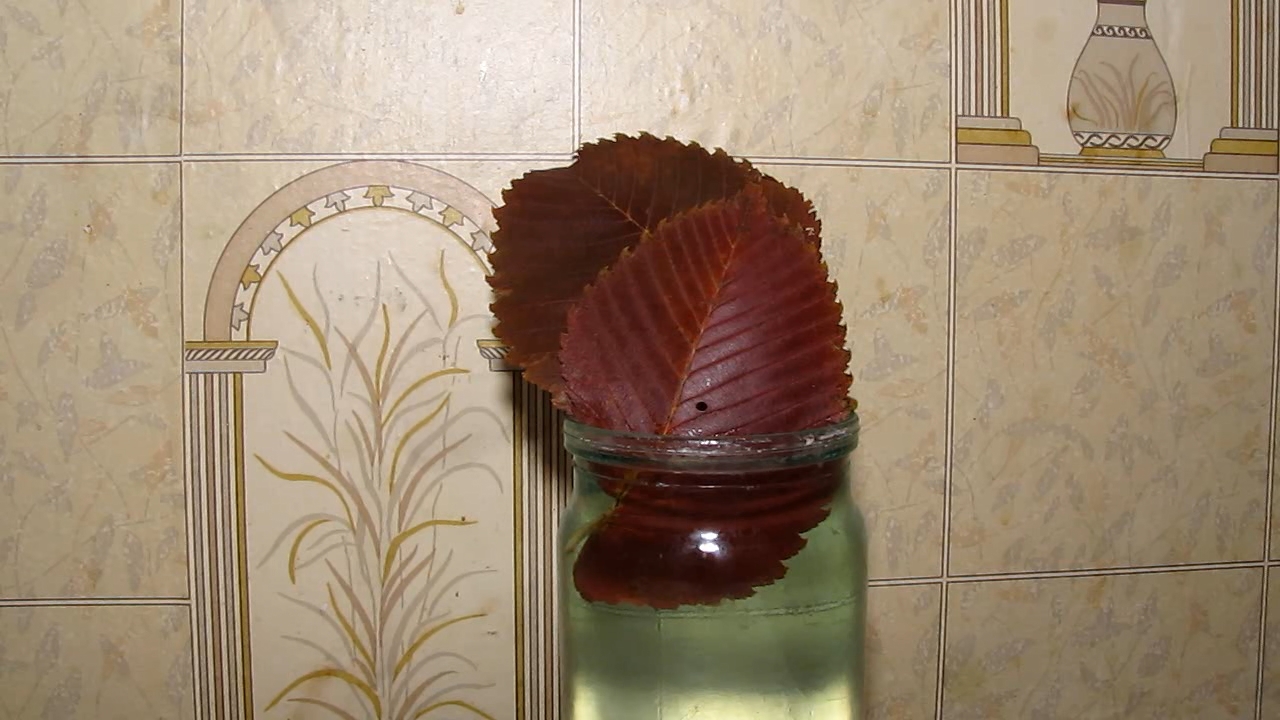
Burgundy autumn leaves become green (treatment of leaves of Ulmus laevis with ammonia) |
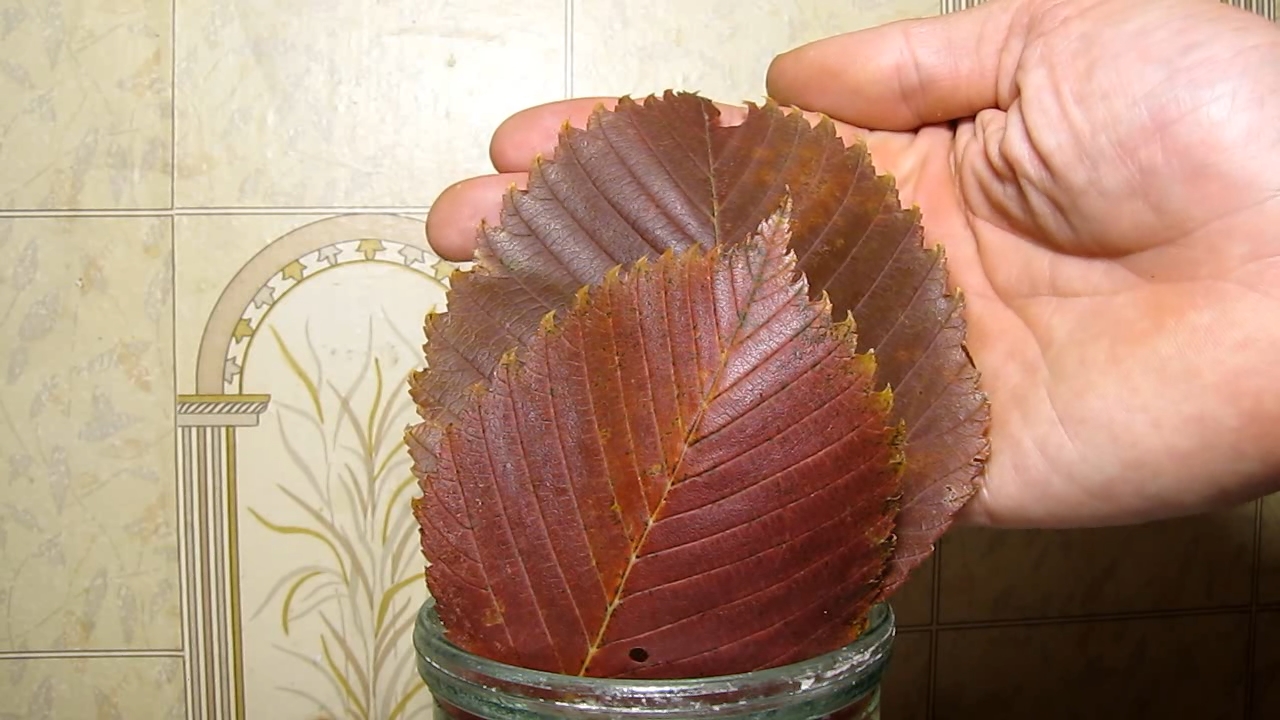
|
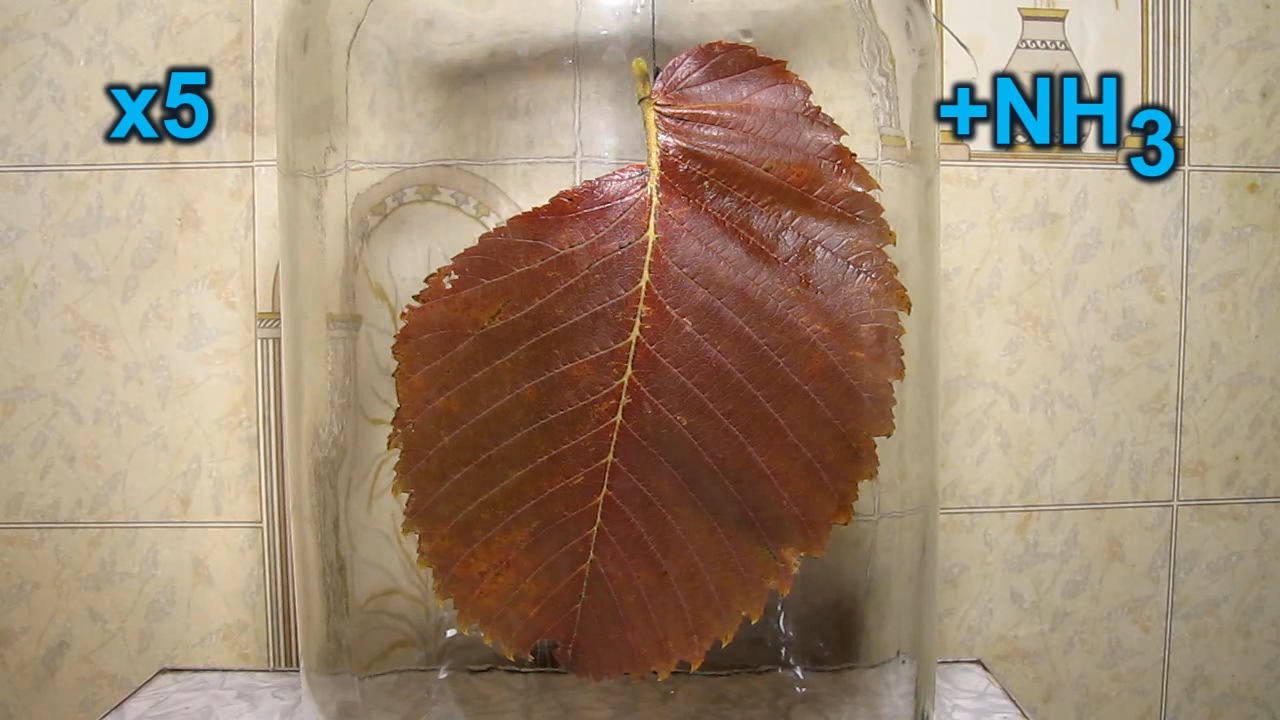
|

|
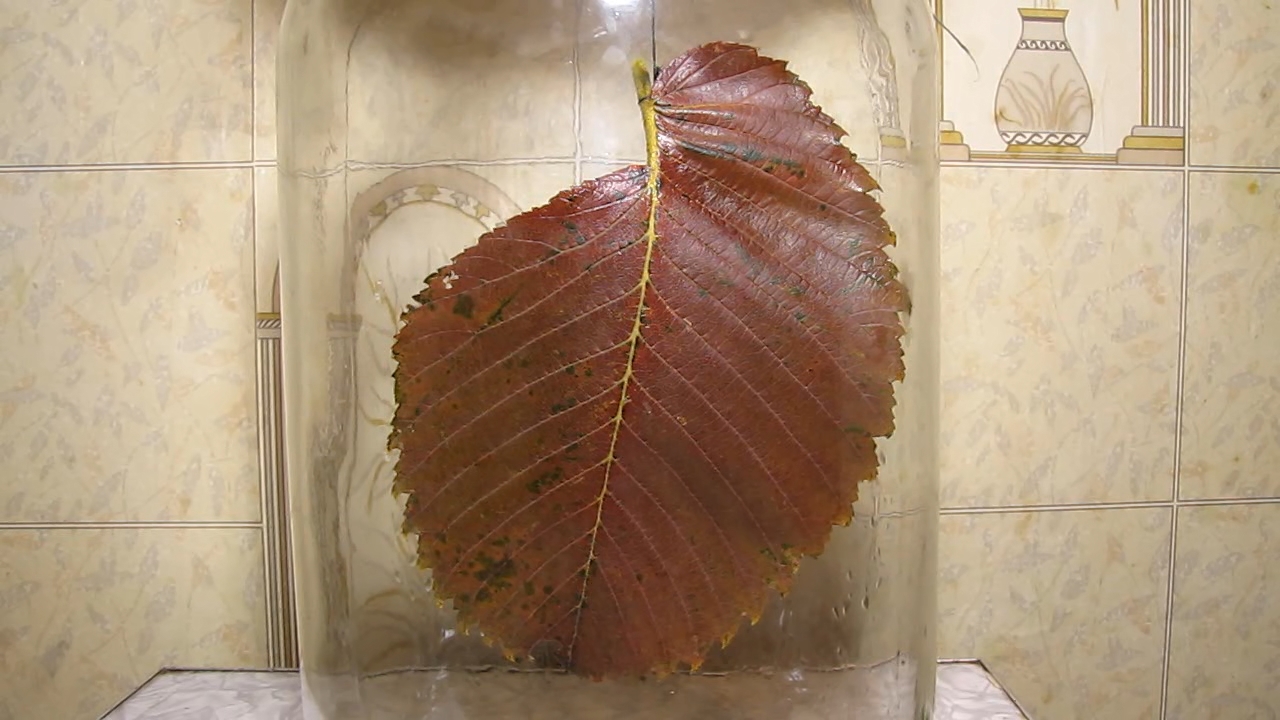
|
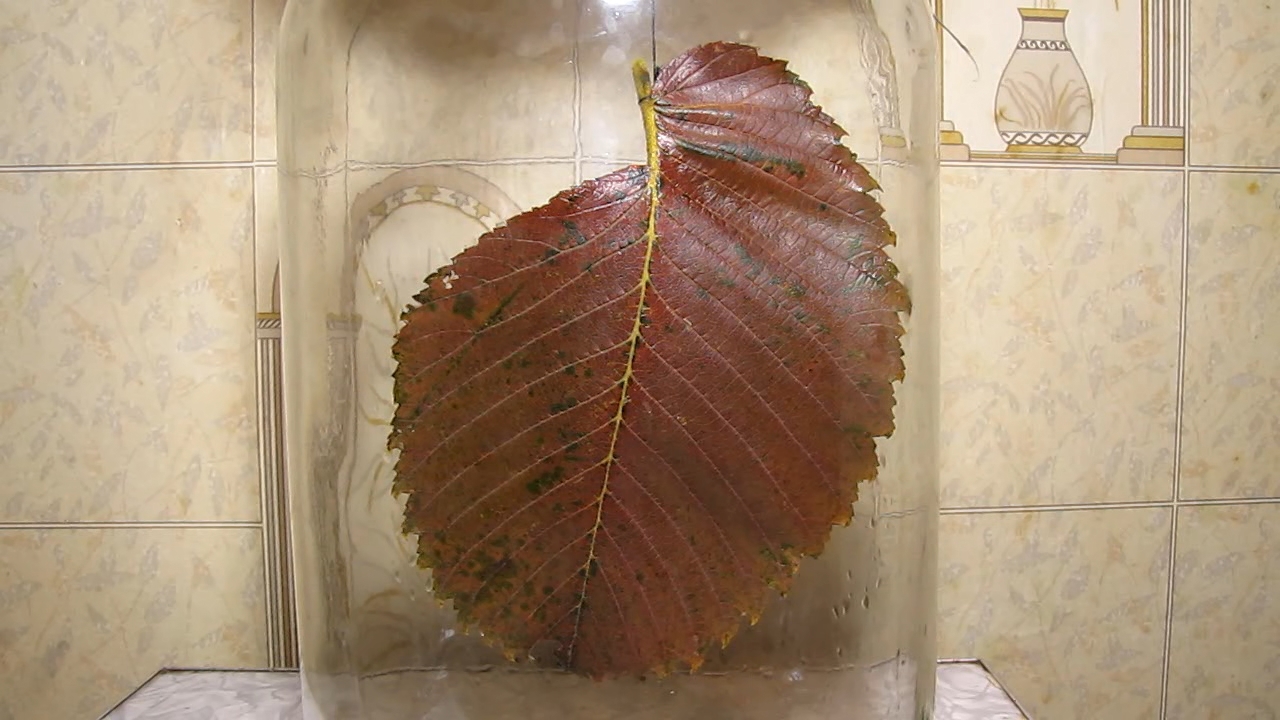
|

|

|
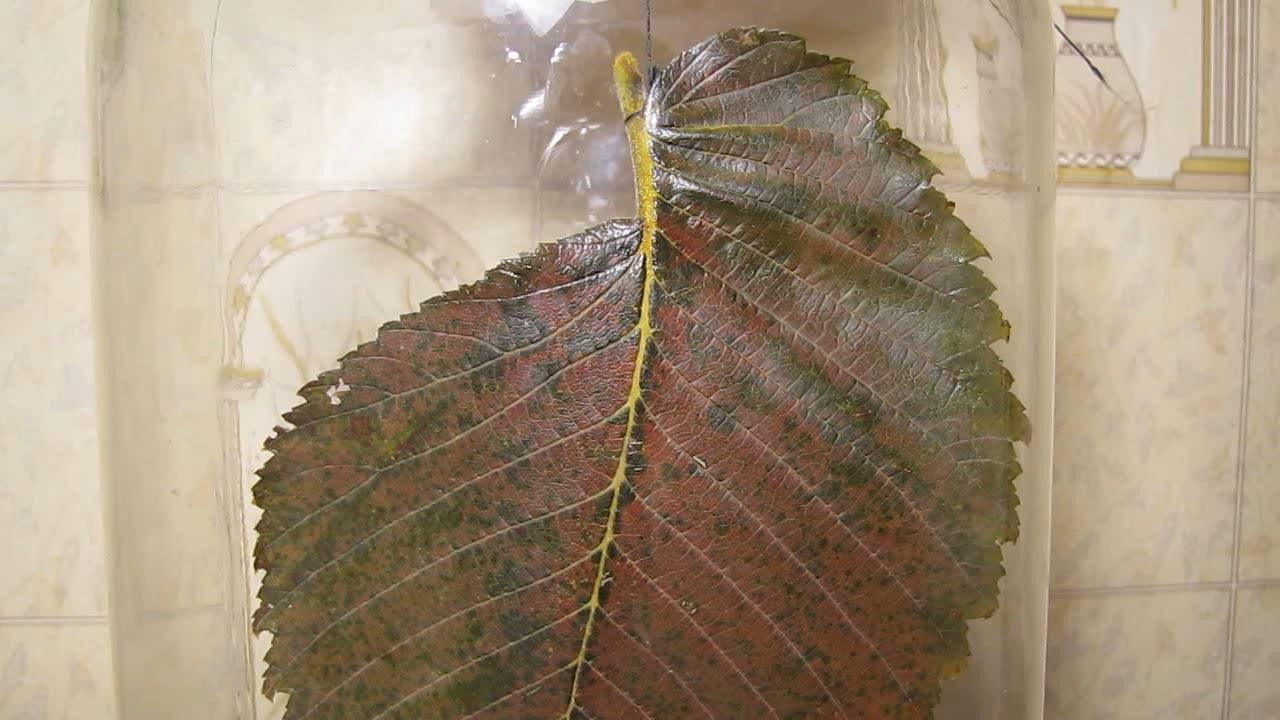
|

|

|
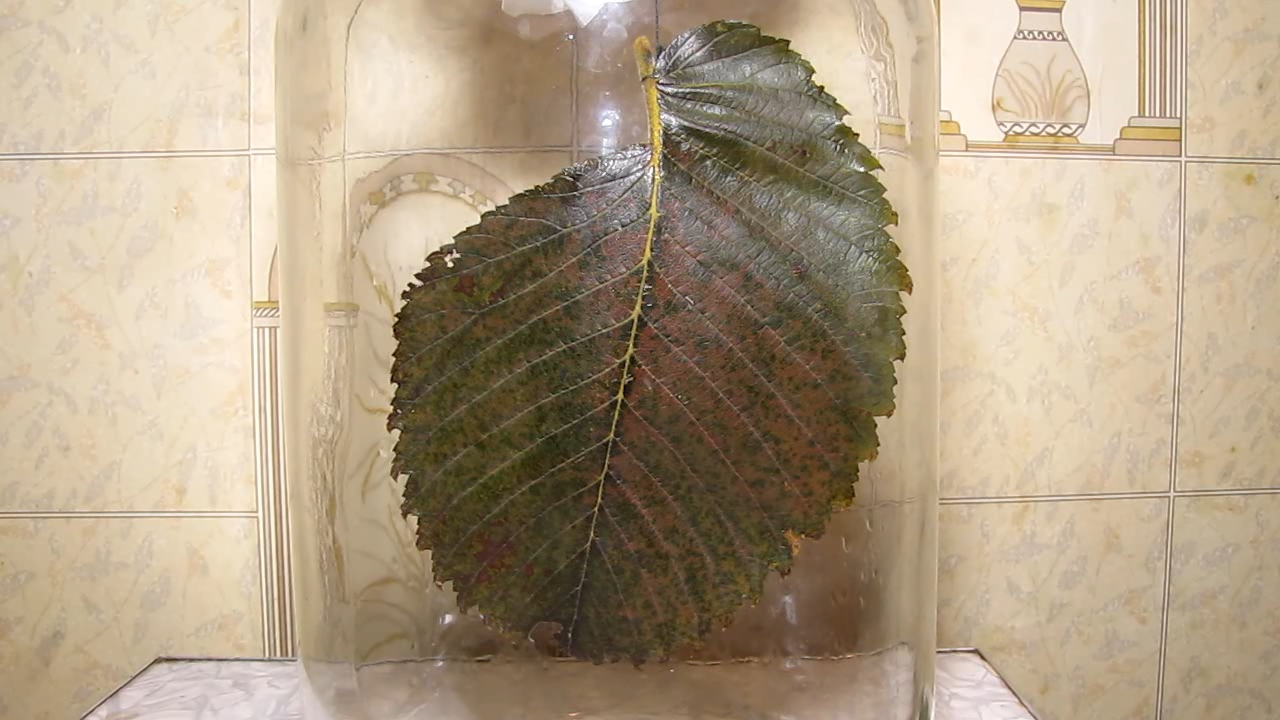
|
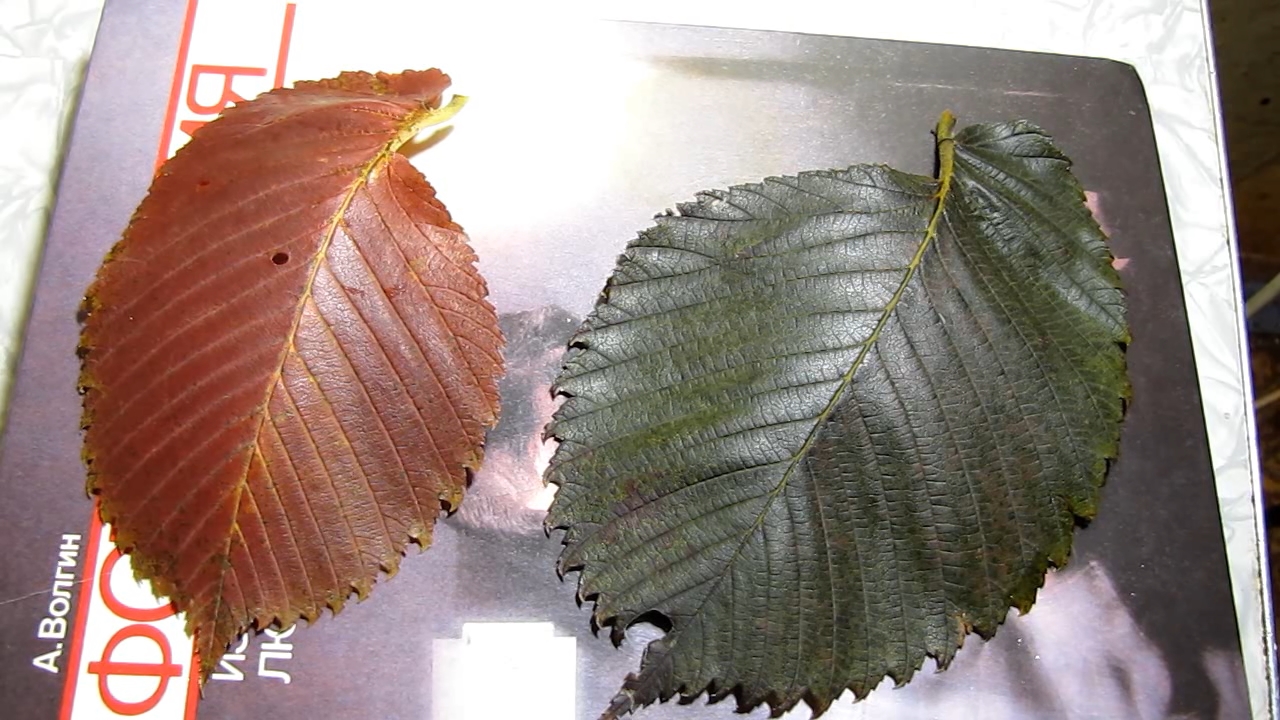
|

|
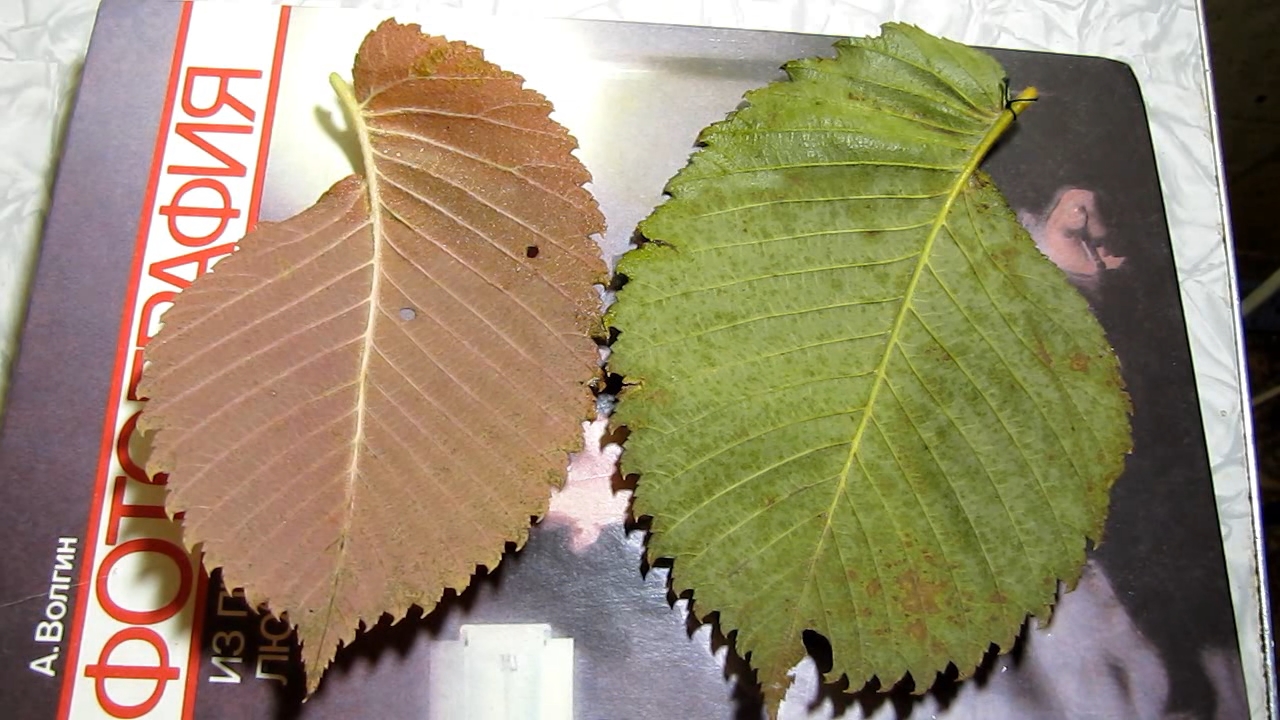
|

|
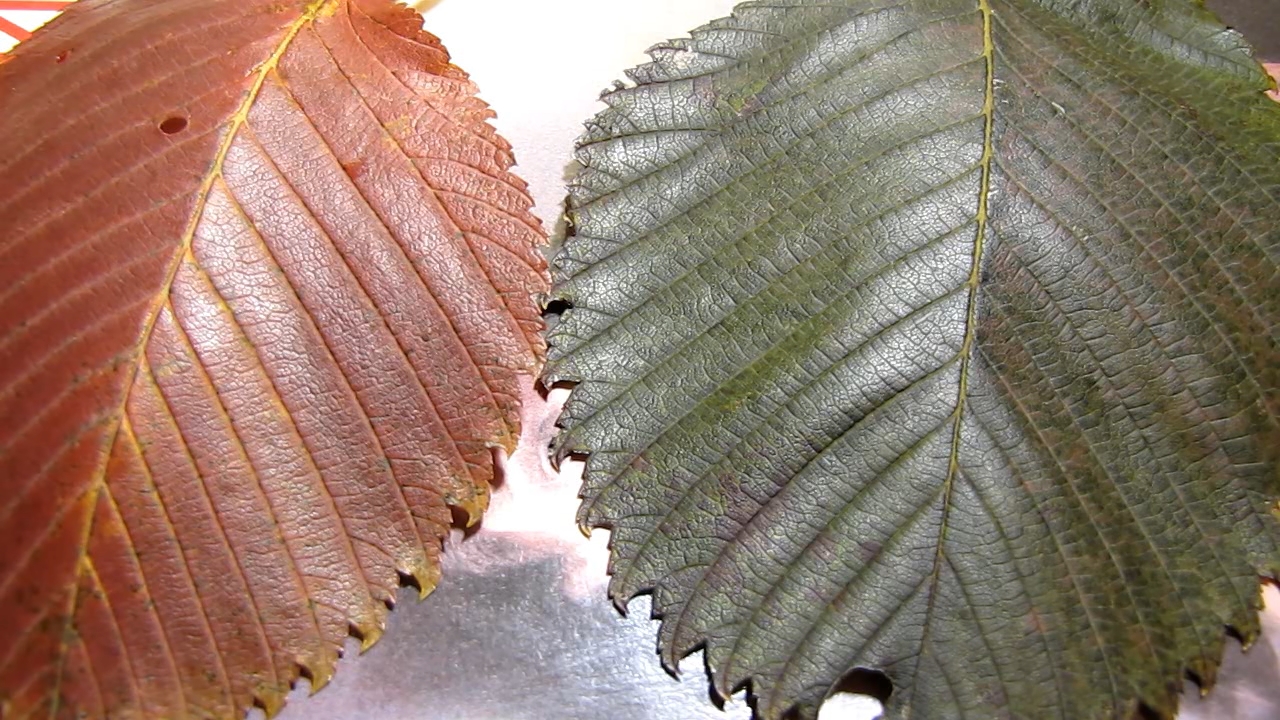
|
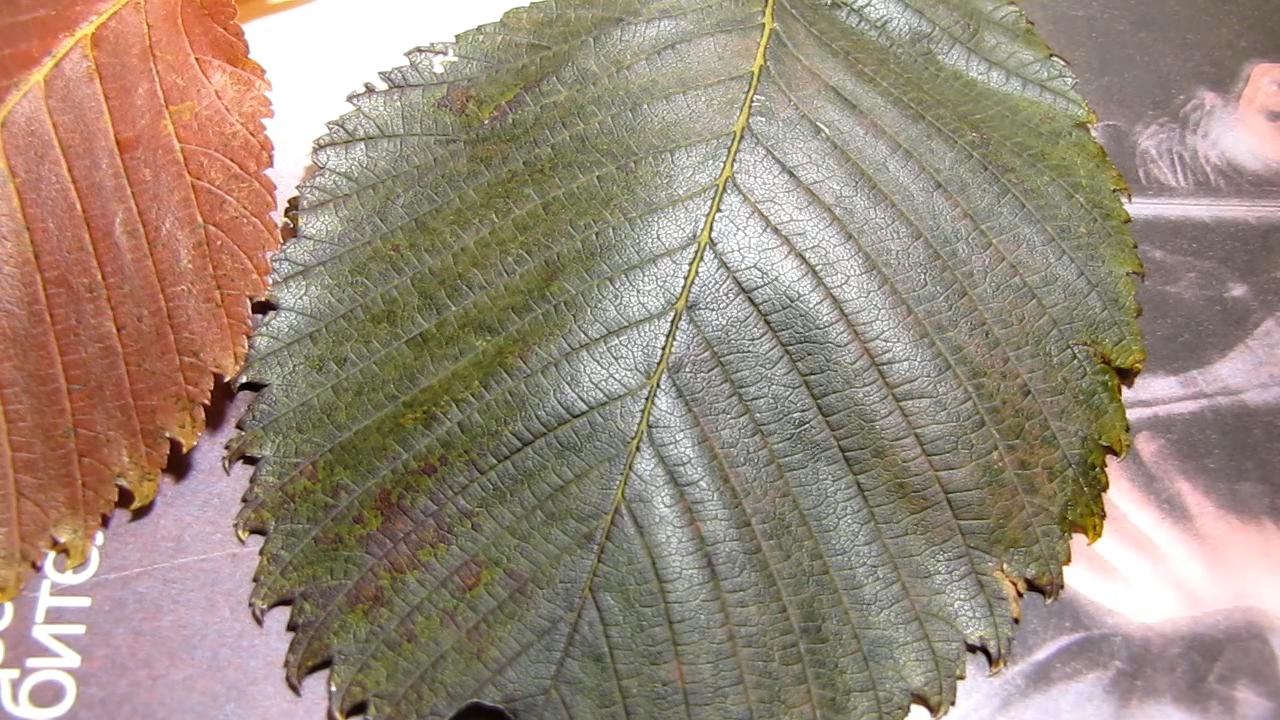
|
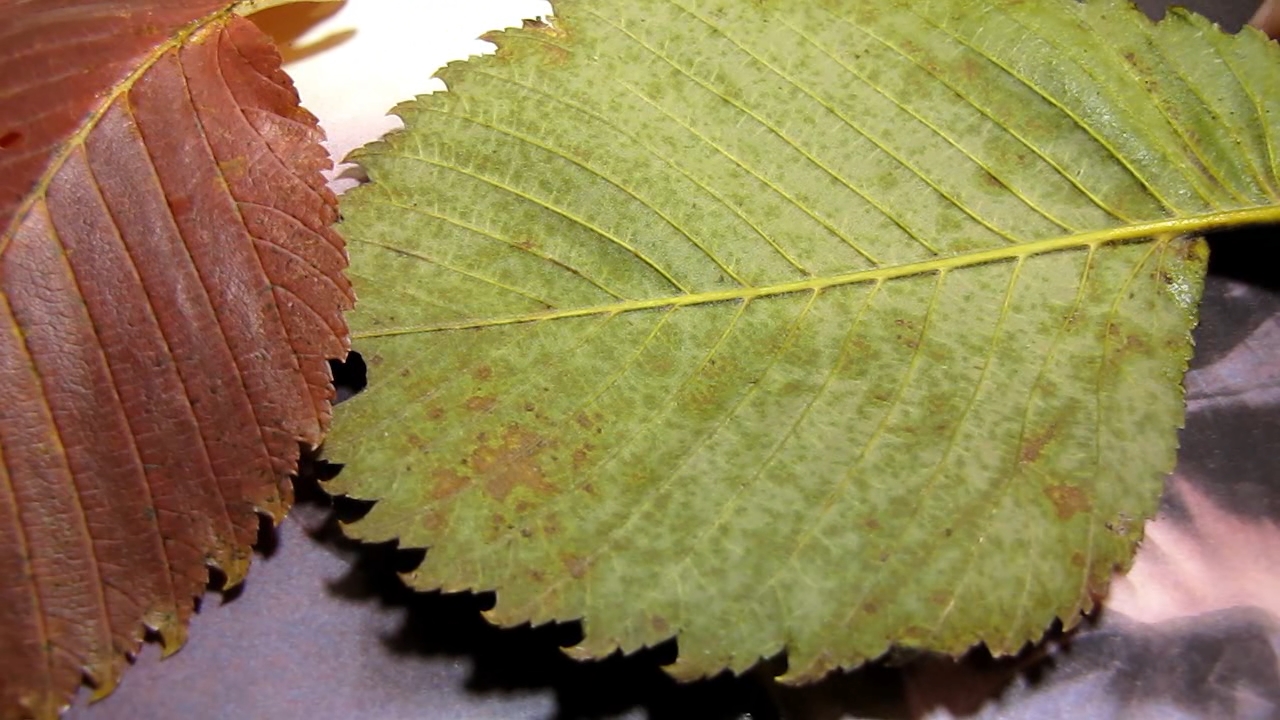
|
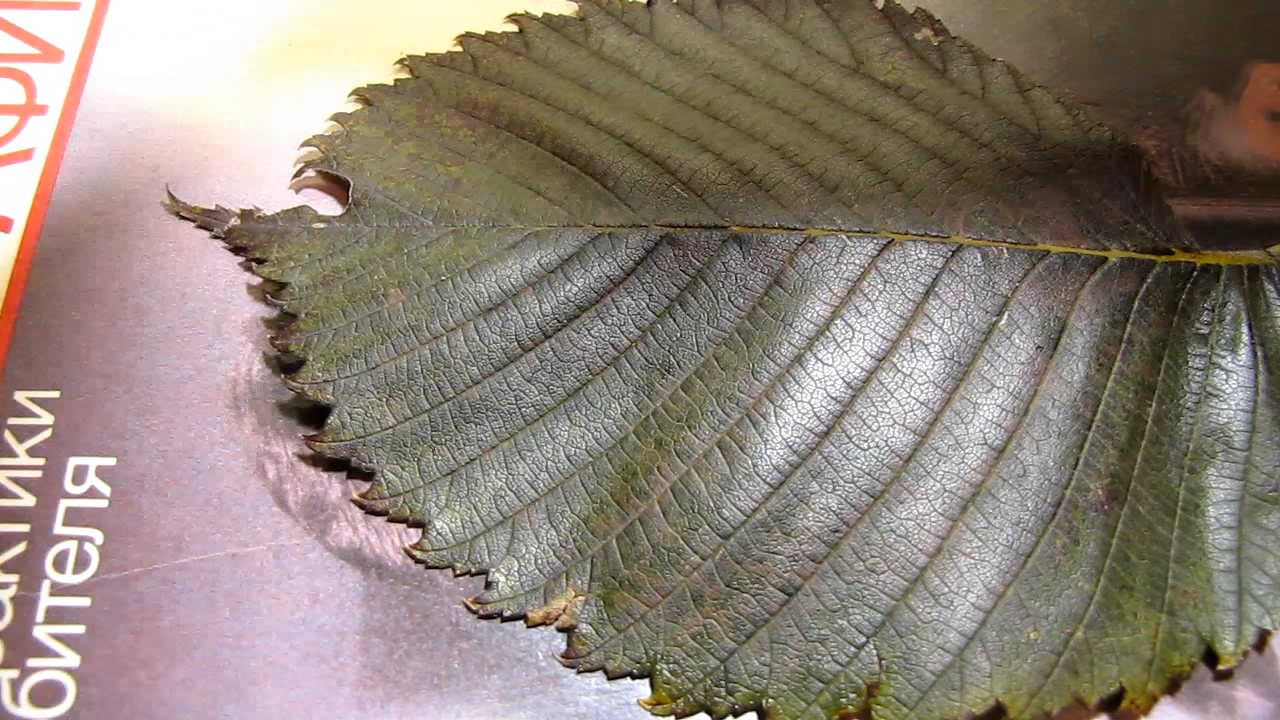
|

|
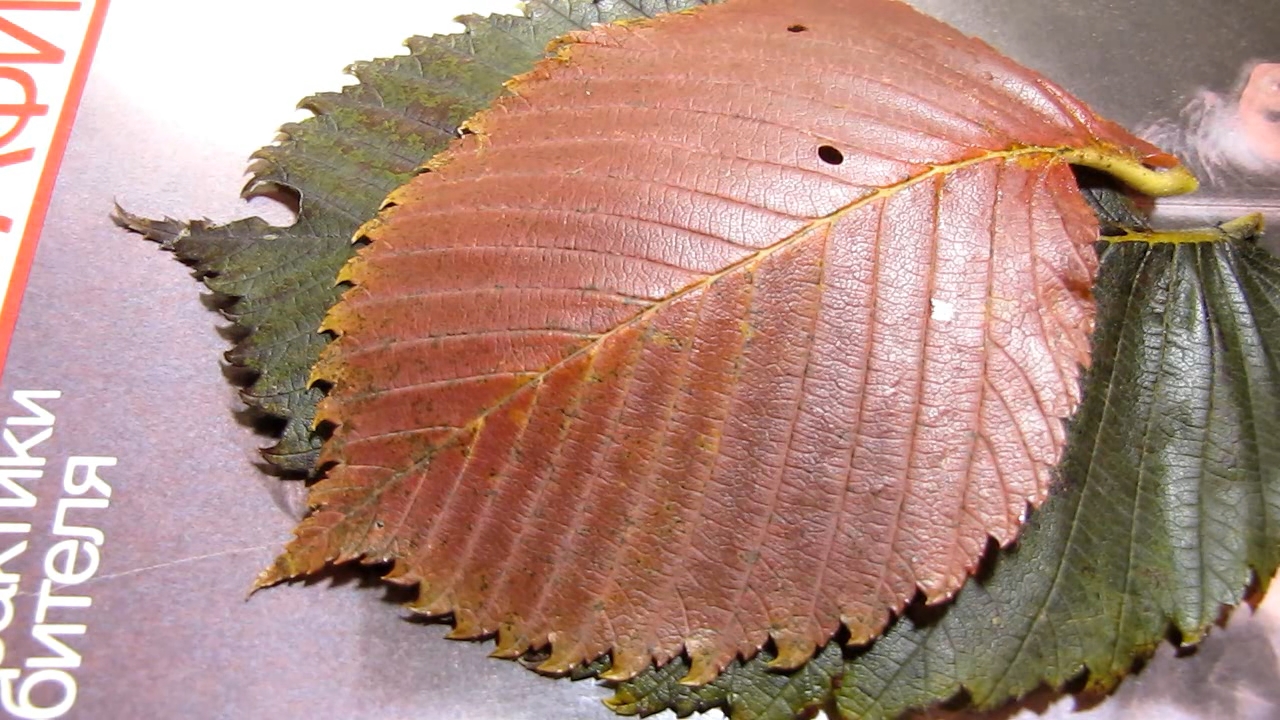
|
|
Red leaves of Pyrus communis, ammonia and acetic acid - pt.27
I planned to finish the experiments with autumn leaves - there was no point in focusing on this topic, varying the leaves of different plants, but by chance, I saw the leaves of a pear tree. The leaves were a mosaic of colours. Some places on the leaves were red and burgundy; the other areas were brown, and some leaves also had yellow zones. In summer, all these leaves were green.The name of the biological species is Pyrus communis (Latin), The common pear (English), Груша дика, або дичка - "wild pear" (Ukrainian); from now on referred to as ''pear''.
I really liked the autumn leaves of the pear, so I decided to do another experiment. The idea was simple: first, I should treat the leaf with ammonia - probably the red leaf will turn green, then I should treat the leaf with acetic acid. I wonder if the pear leaf will return to its original red (or combined) colour. I took two pear leaves. The first one was used for experimentation. Its colour was predominantly red, but some areas of the leaf were brown. The second leaf served as a control sample - it was not treated with the reagents. This leaf was predominantly red but also had brown and yellow areas. In order not to be confused with colours and shades, let us call both objects "red leaf" (especially since there is no exact correspondence between the names of colours in the Ukrainian and English languages - I could get confused). I fixed the red pear leaf in a glass and added a concentrated ammonia solution (trying to wet the leaf's surface to speed up the colour change). Dark spots began to appear on the pear leaf, their area grew, and the spots merged. Later, it became noticeable that the colour of the spots was dark green. On a light background, the colour looked almost black, but on a dark background, it was clear that the colour was dark green, slightly darker than the colour of pear leaves in summer. The colour transition occurred slowly, so I wet the leaf with ammonia several times (to speed the process up). As a result, almost the entire leaf turned dark green. Next stage. The dark green leaf (treated with ammonia) was fixed in another glass. I added glacial acetic acid (at the same time, I also wet the surface of the leaf with the liquid). Red areas appeared on the dark green surface, slowly growing and uniting. Ultimately, the leaf turned not red but brown; brown areas with different colour intensities formed on its surface. After treatment with ammonia and then treatment with acetic acid, the pear leaf became similar to the original one, but significant differences remained: its colour became darker and browner. |
|
Красные листья Pyrus communis (Дикой груши), аммиак и уксусная кислота - ч.27
Я планировал завершить эксперименты с осенними листьями - не было смысла зацикливаться на этой теме, варьируя листья разных растений, но случайно увидел листья груши. Листья представляли собой цветную мозаику: местами они были красные и бордовые, местами - коричневые, некоторые листья имели также желтые участки. Летом все эти листья были зелеными. Название биологического вида - Pyrus communis (лат.), The common pear (англ.), Груша дика, або дичка (укр.), Груша обыкновенная, или дикая груша (рус.), далее - "груша". Осенние листья груши мне очень понравились, поэтому решил провести еще один эксперимент. Идея была простой: сначала подействовать на лист аммиаком - вероятно, красный лист станет зеленым, потом подействовать на лист уксусной кислотой. Интересно, вернет ли лист груши свою исходную красную (точнее - комбинированную) окраску? Взял два листа груши. Первый из них предназначен для эксперимента. Цвет его был преимущественно красный, некоторые участки листа были скорее коричневыми. Второй лист служил контрольным образцом - он не подвергался обработке. Этот лист был преимущественно красным, но имел также коричневые и желтые участки. Чтобы не путаться с цветами и оттенками, назовем оба объекта "красный лист" (тем более между украинским/русским и английским языками нет точного соответствия названий цветов и оттенков - я могу напутать). Закрепил красный лист груши в стакане, добавит концентрированный раствор аммиака (стараясь смочить поверхность листа, чтобы ускорить изменение окраски). На листе груши стали появляться темные пятна, их площадь росла, пятна объединились. Позже стало заметно, что цвет пятен - темно-зеленый. На светлом фоне цвет выглядел почти черным, но на темном фоне было видно, что цвет - темно-зеленый, чуть темнее, чем цвет листьев груши летом. Переход цвета происходил медленно, чтобы его ускорить я несколько раз смочил поверхность листа аммиаком. В результате почти весь лист стал темно-зеленым. Следующий этап. Обработанный аммиаком темно-зеленый лист закрепил в другом стакане. Добавил ледяную уксусную кислоту (при этом тоже смочил поверхность листа жидкостью). На темно-зеленой поверхности появились красные участки, которые медленно росли и объединились. В конечном итоге лист стал не красным, а коричневым, на его поверхности образовались коричневые участки с разной интенсивностью окраски. После обработки аммиаком, а потом обработки уксусной кислотой лист груши стал похож на исходный, но остались существенные отличия: его окраска стала более темной и более коричневой. |
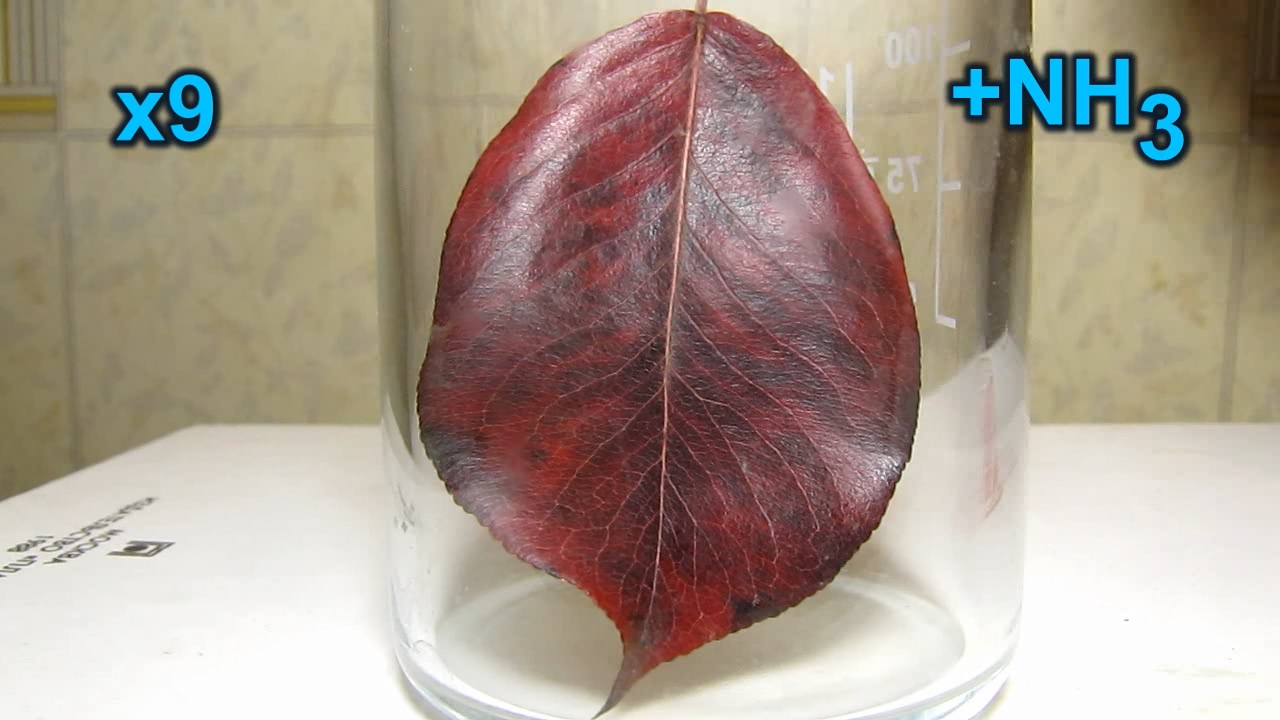
|
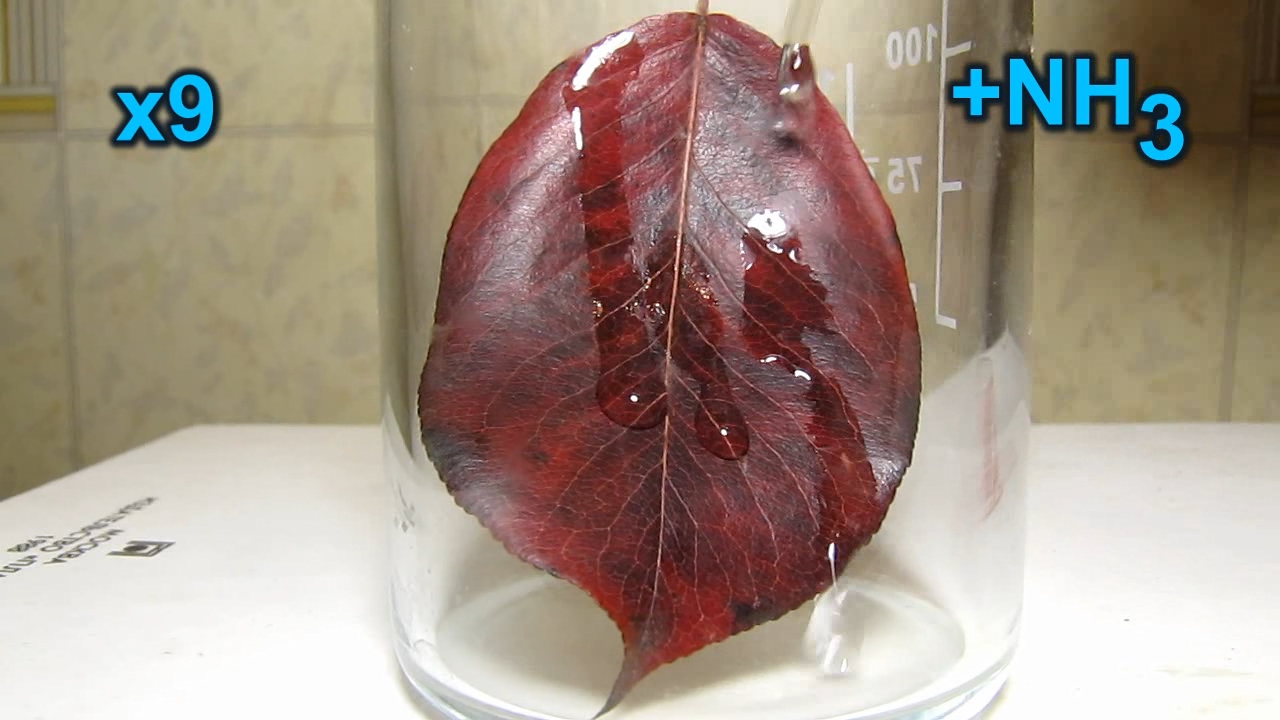
|
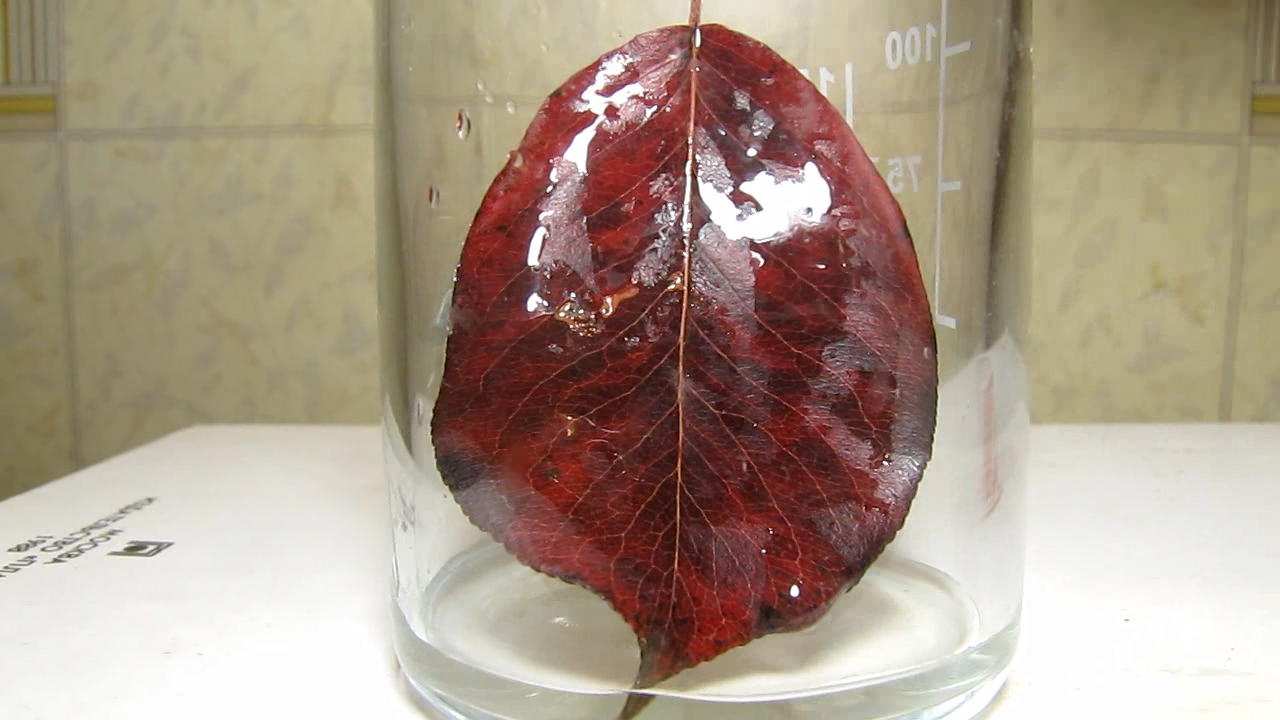
|
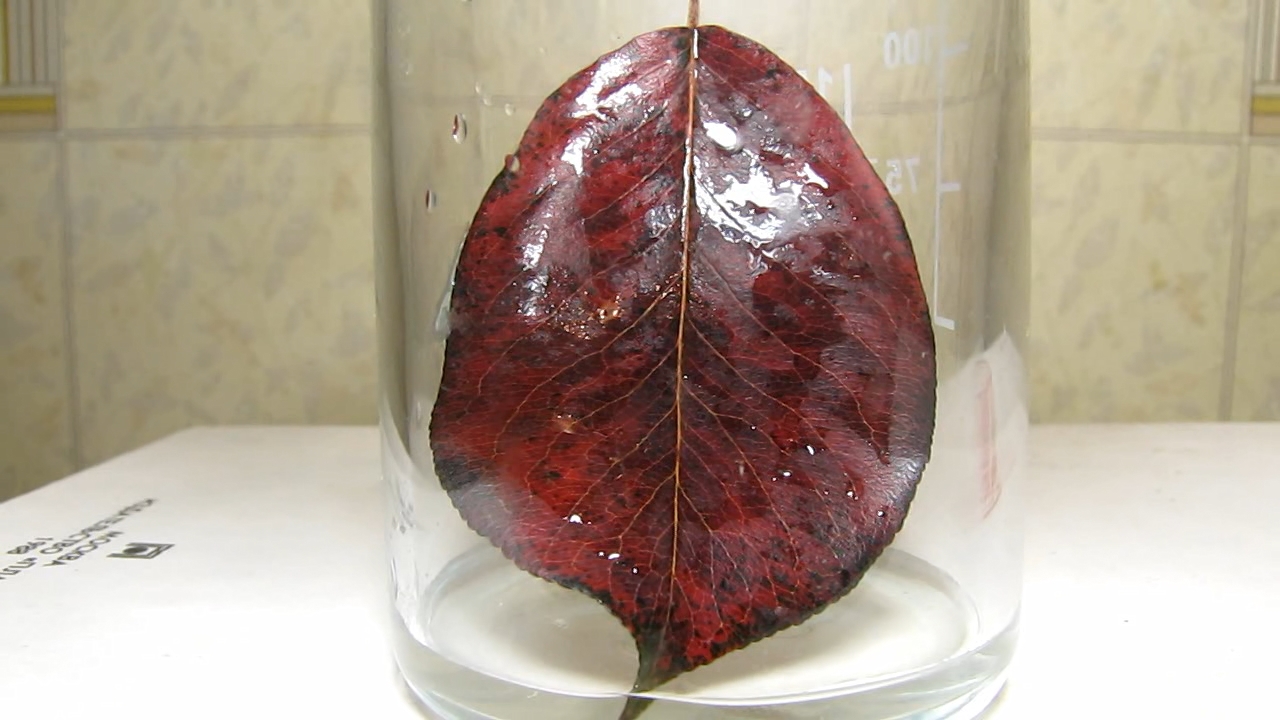
|
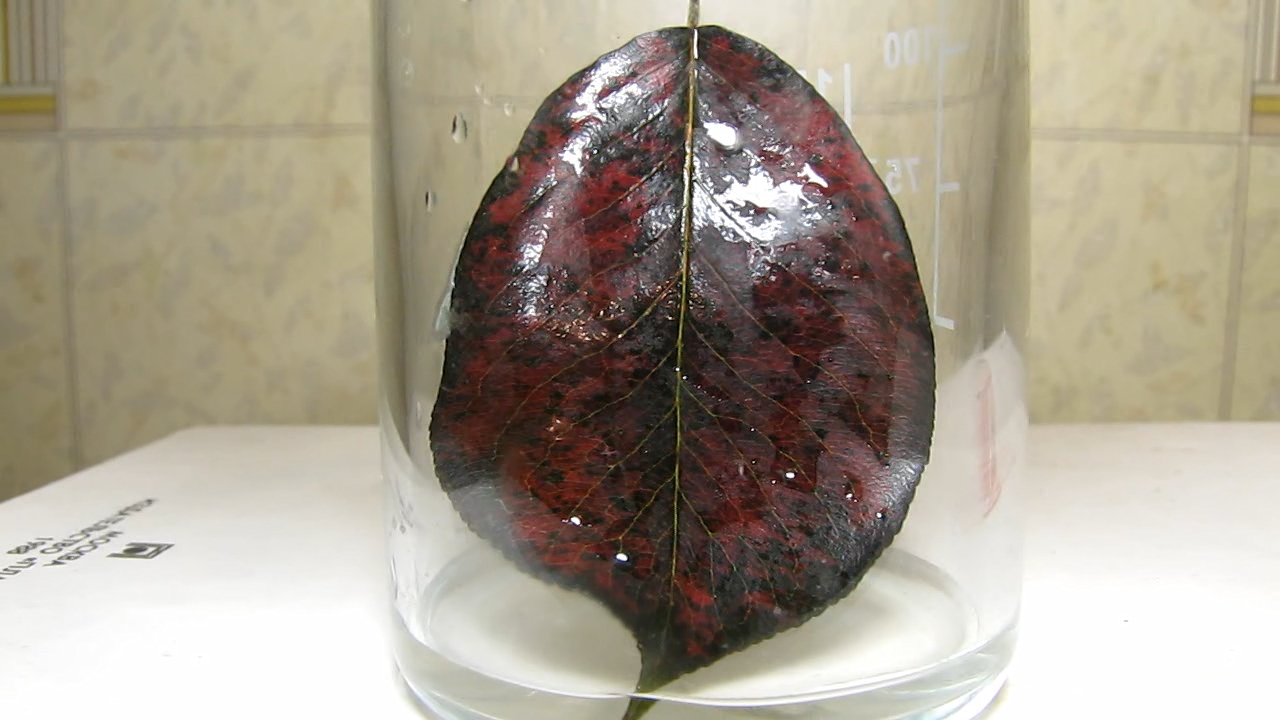
|

|
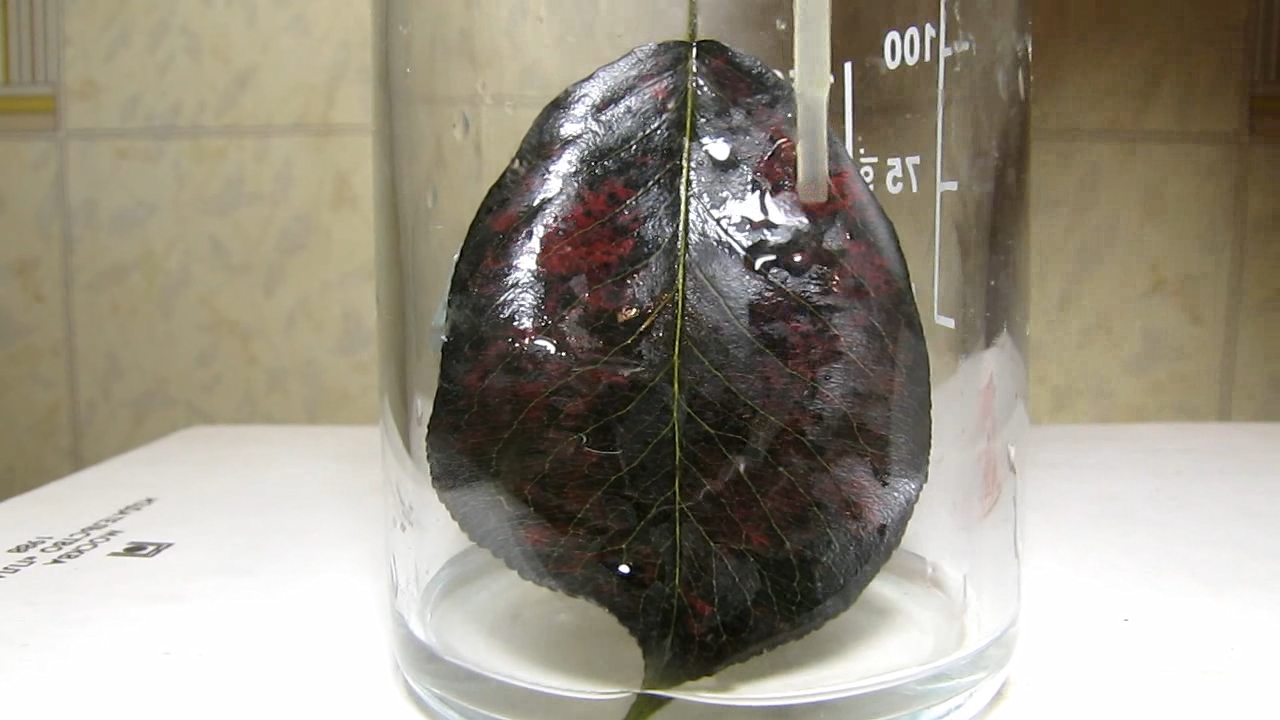
|

|
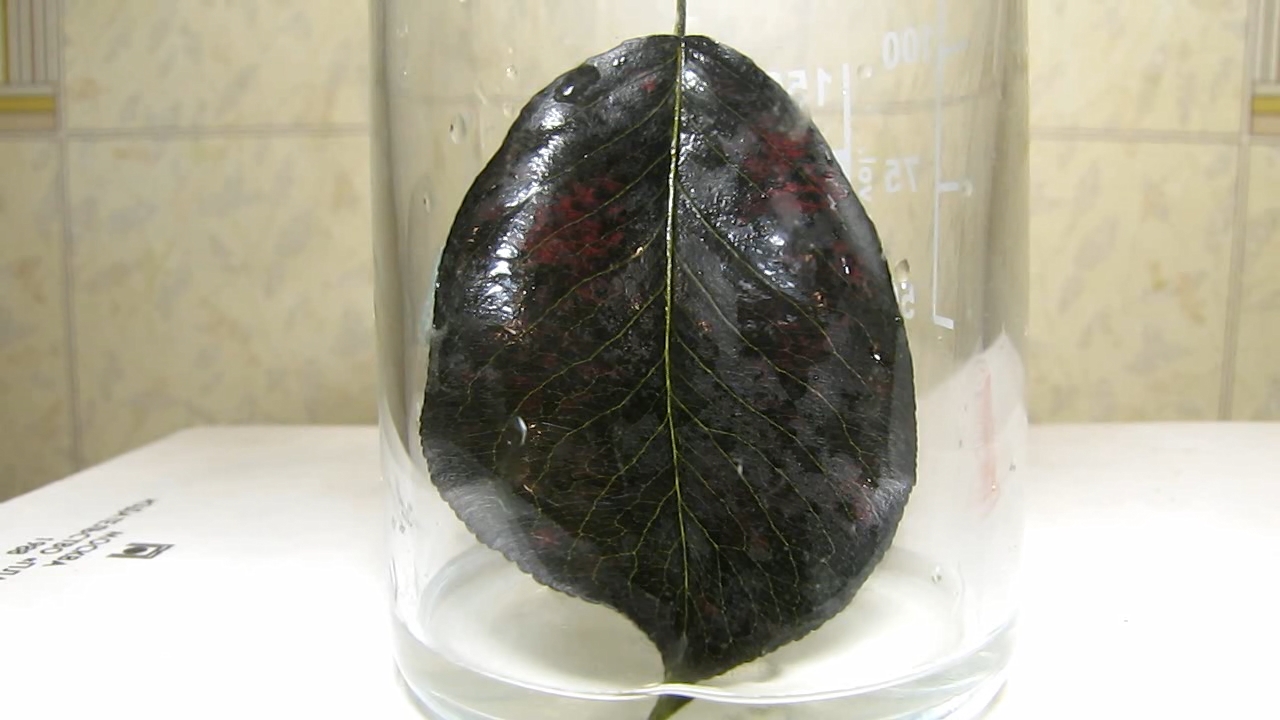
|
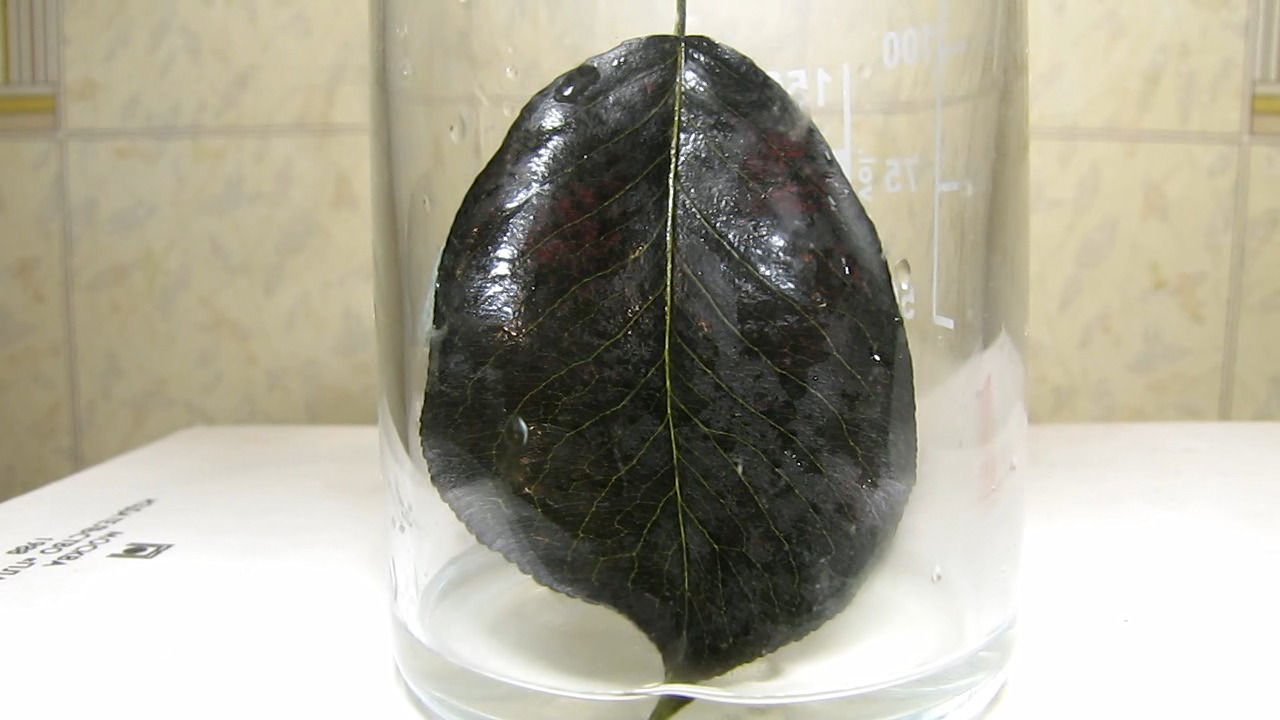
|

|
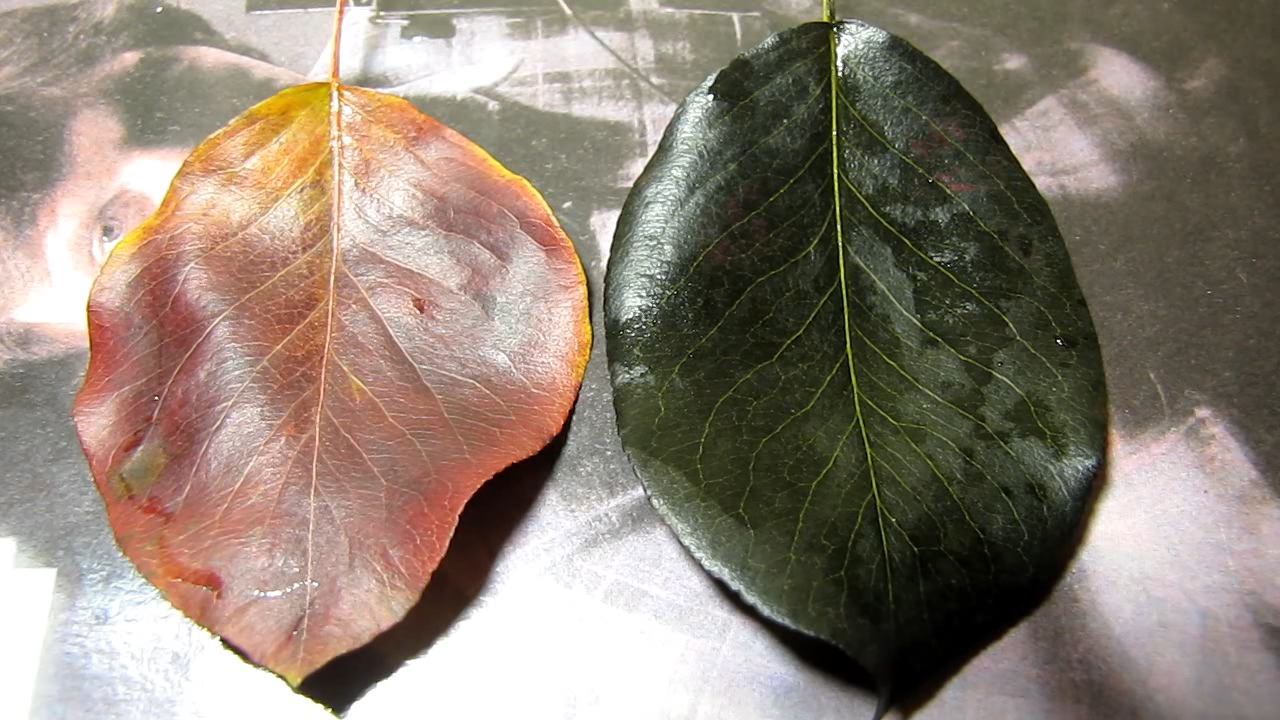
|

|
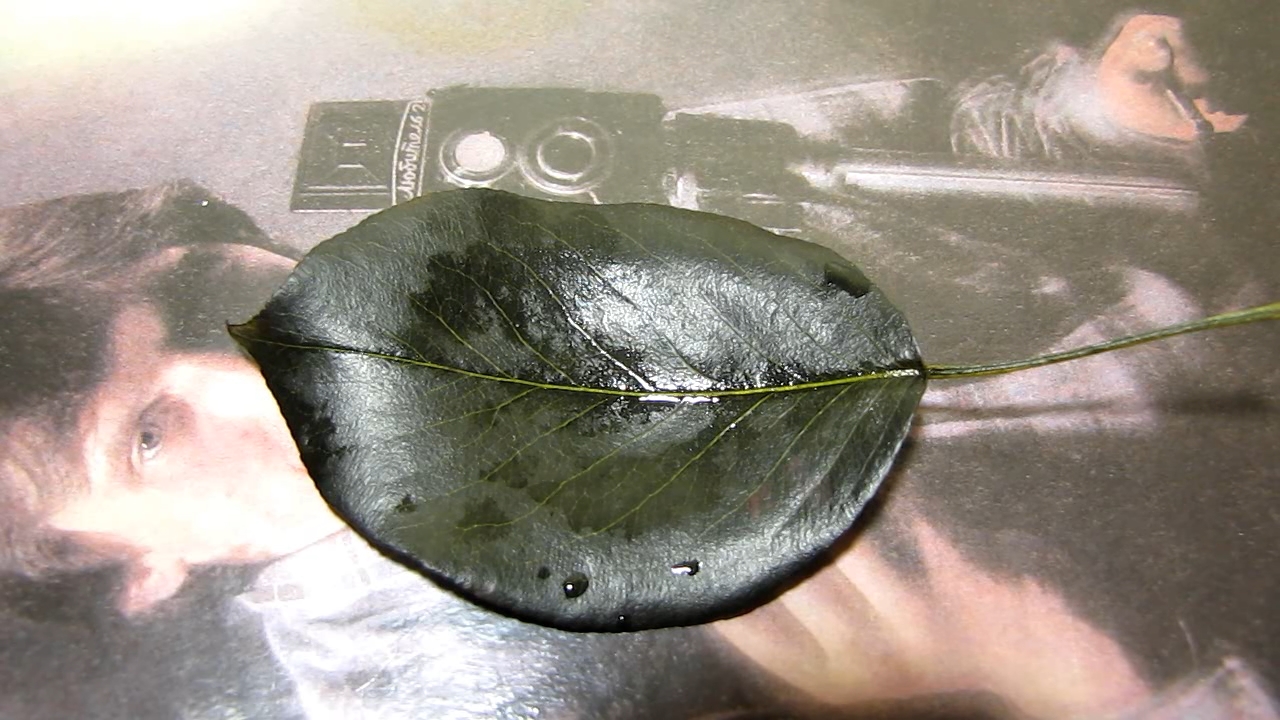
|
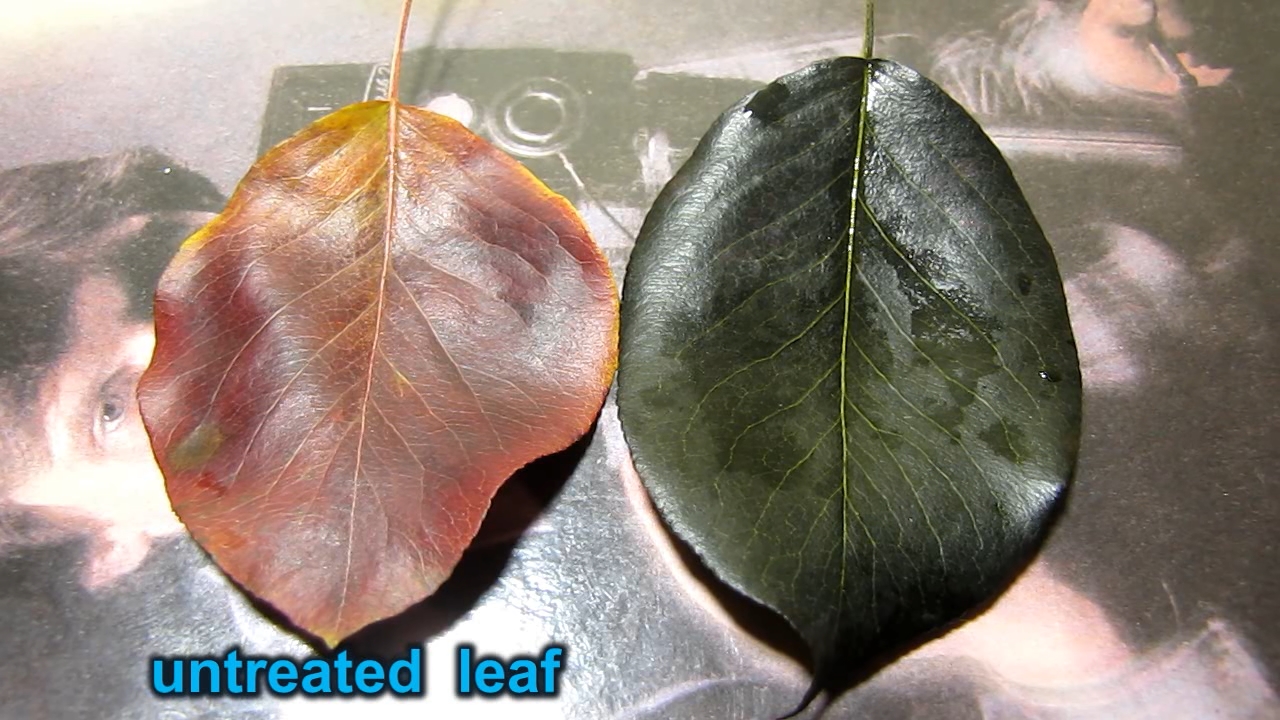
|
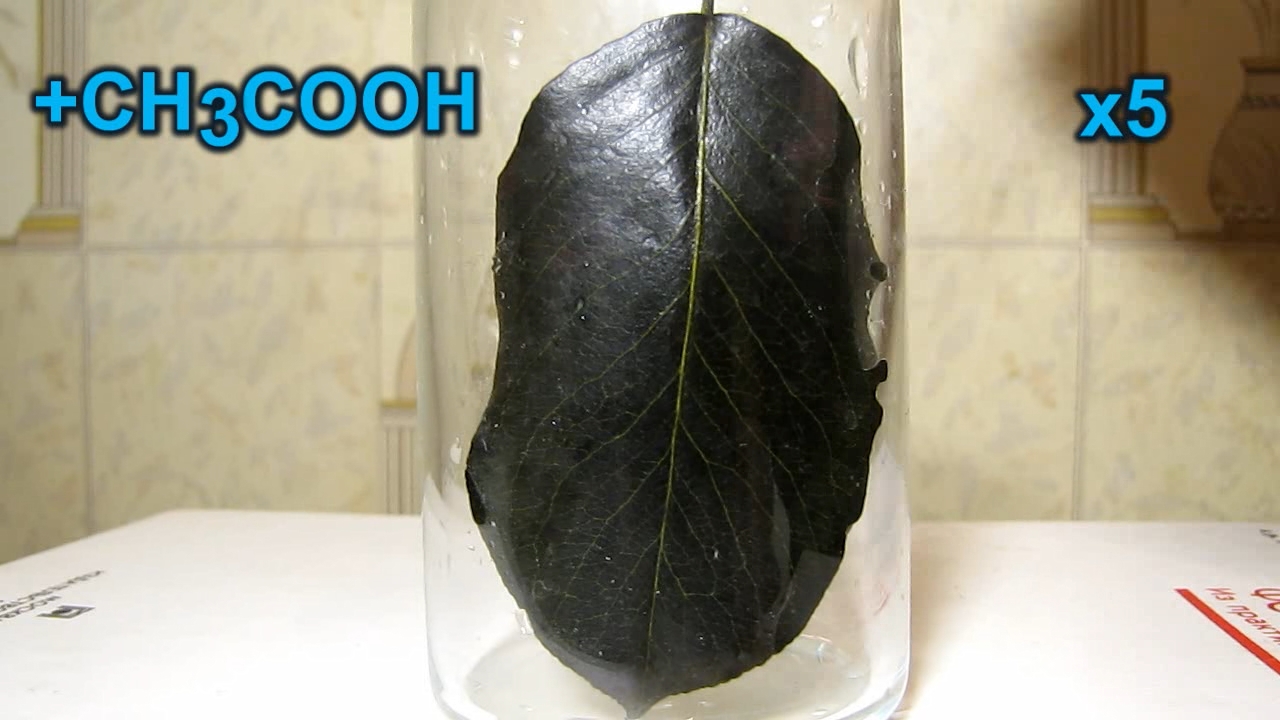
|
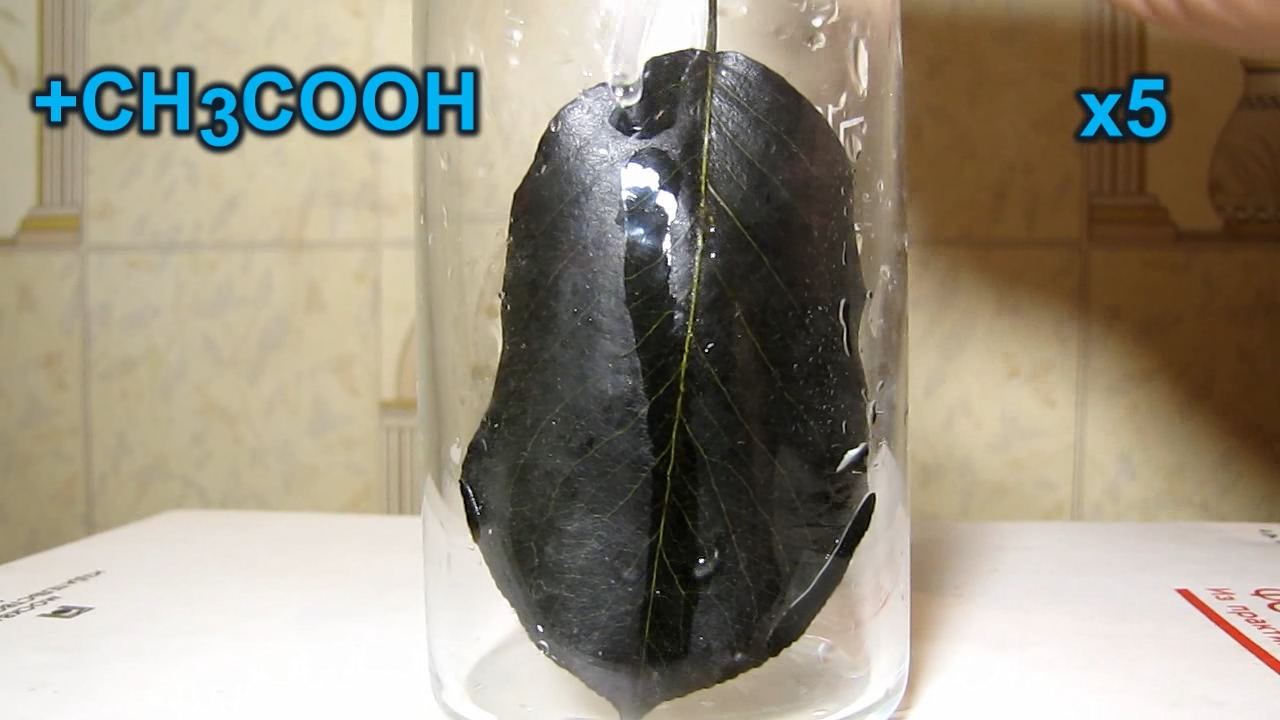
|

|

|
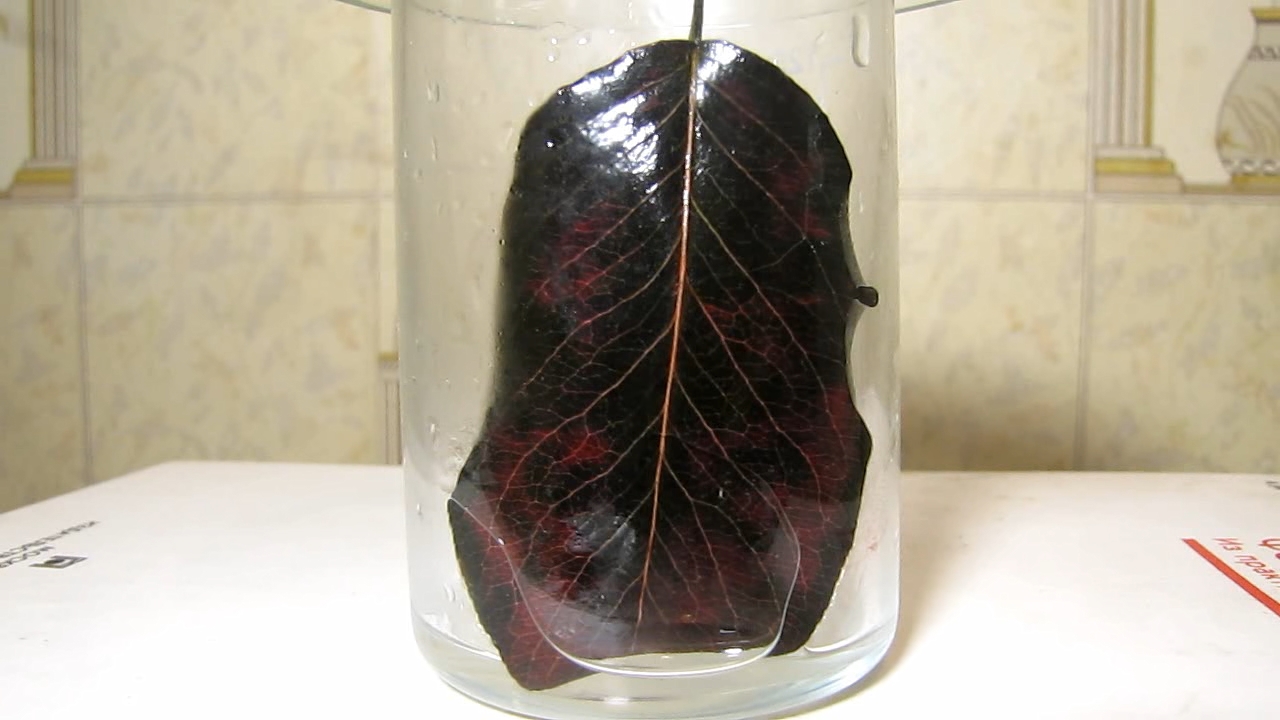
|
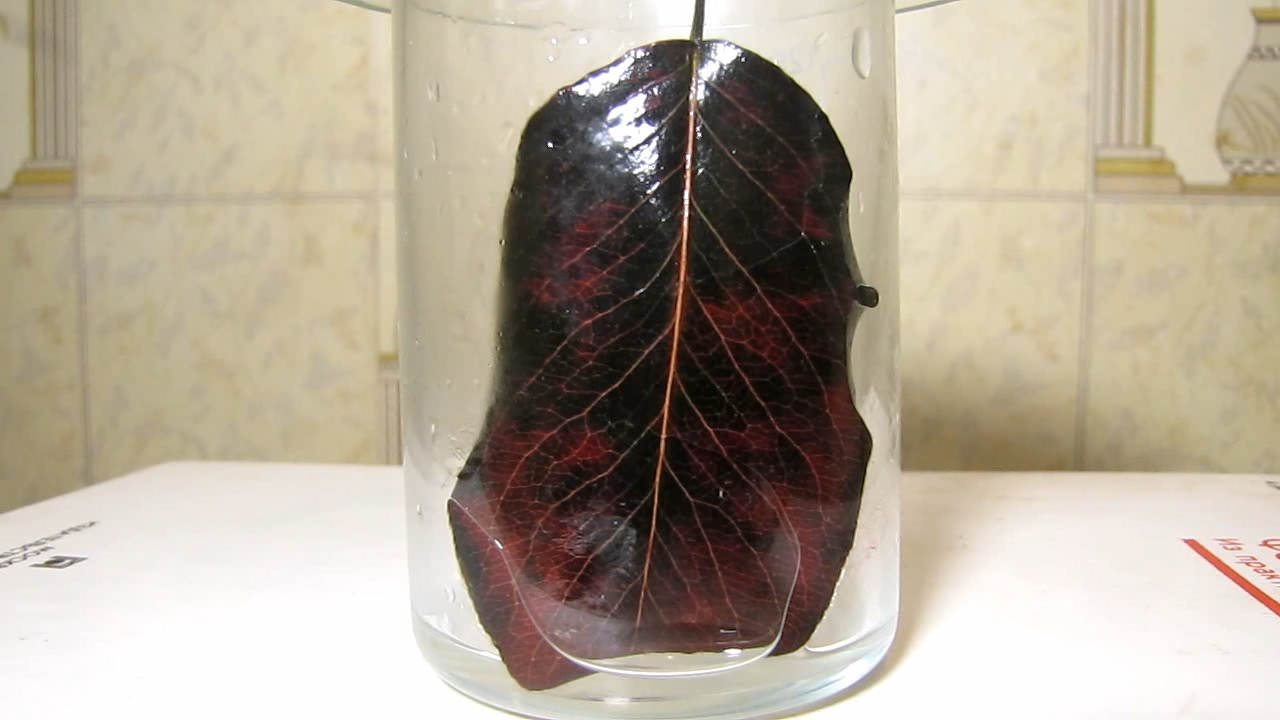
|

|

|

|

|

|